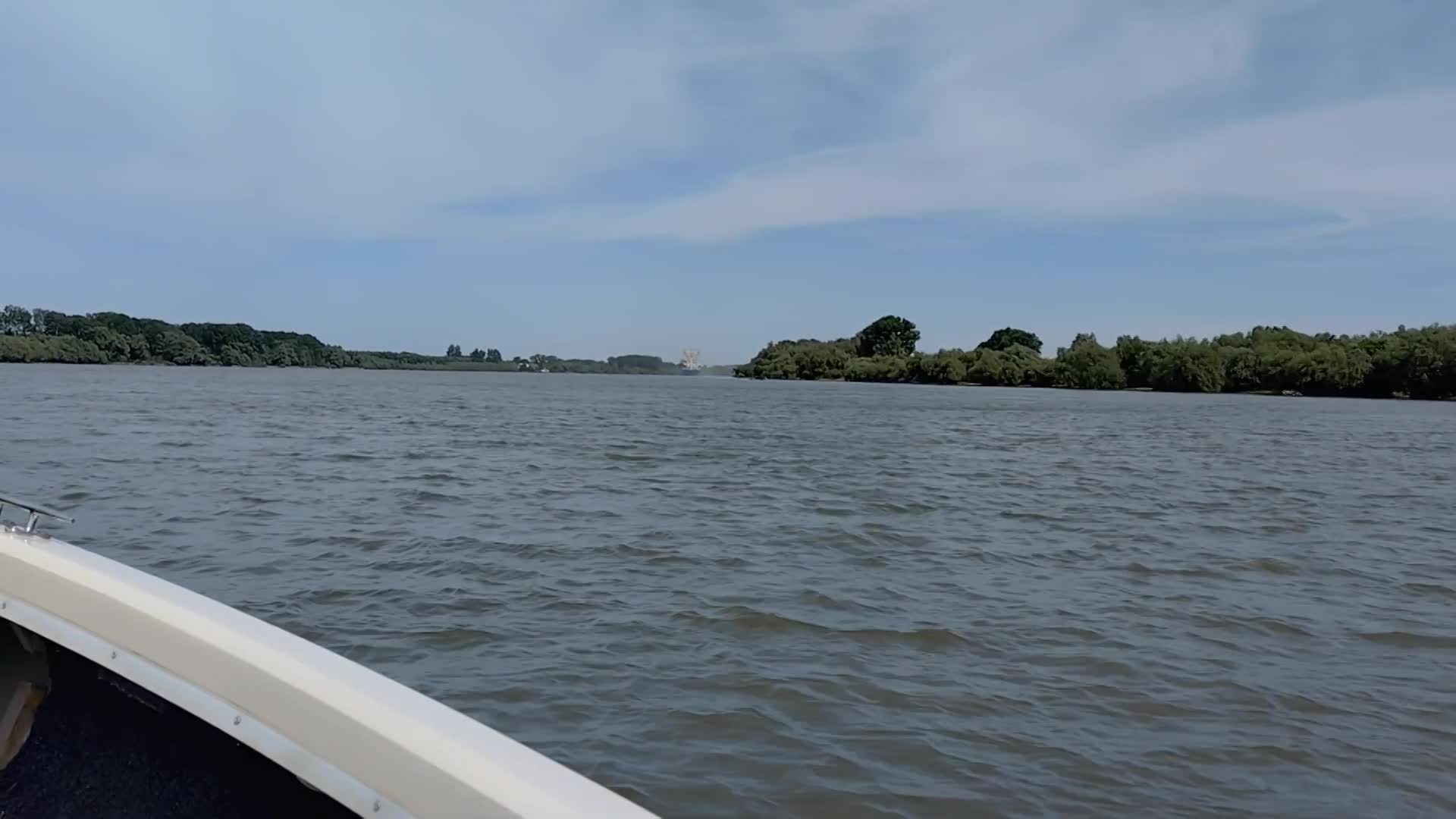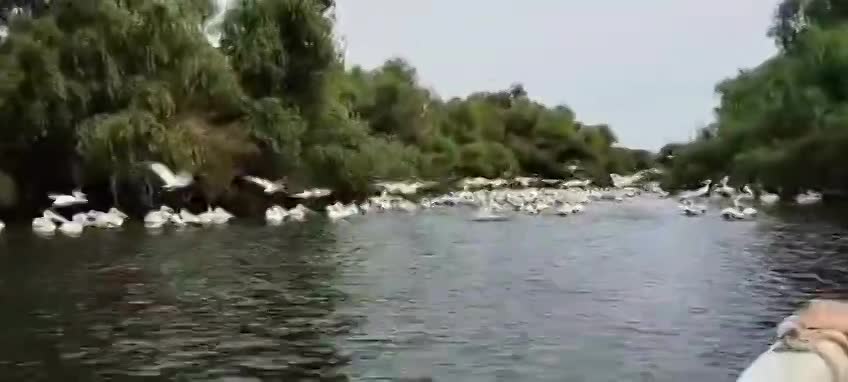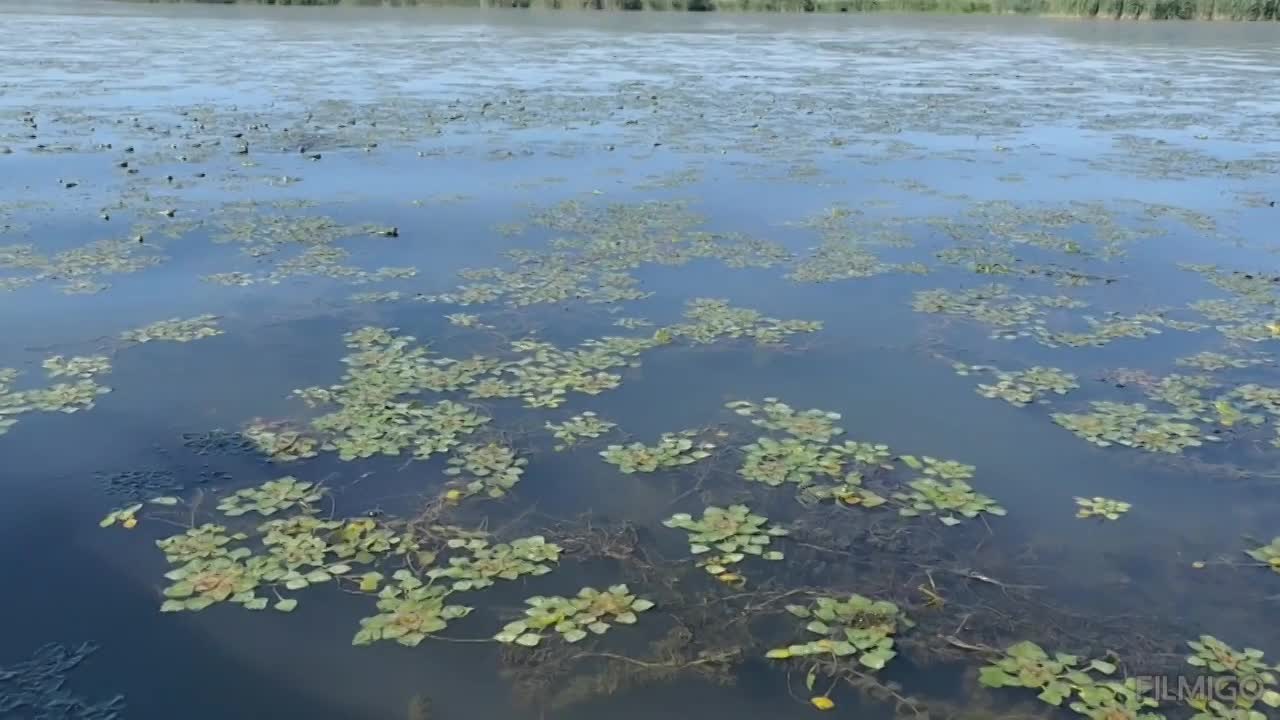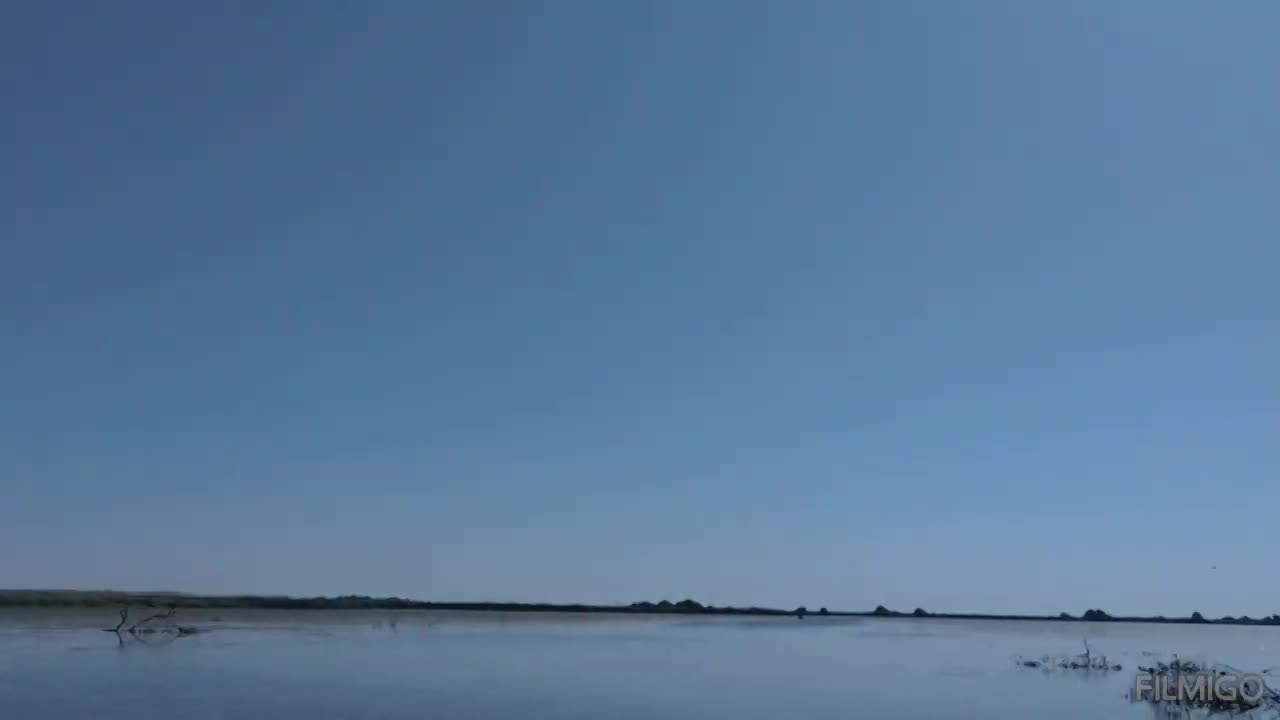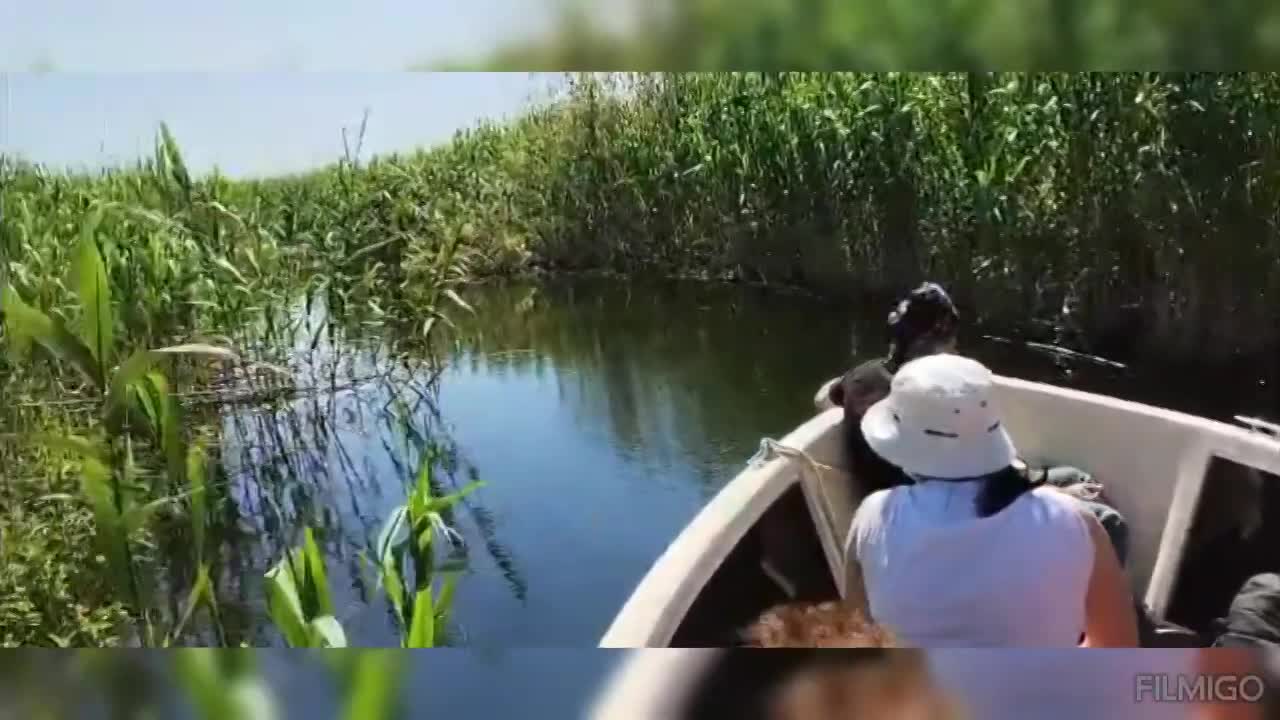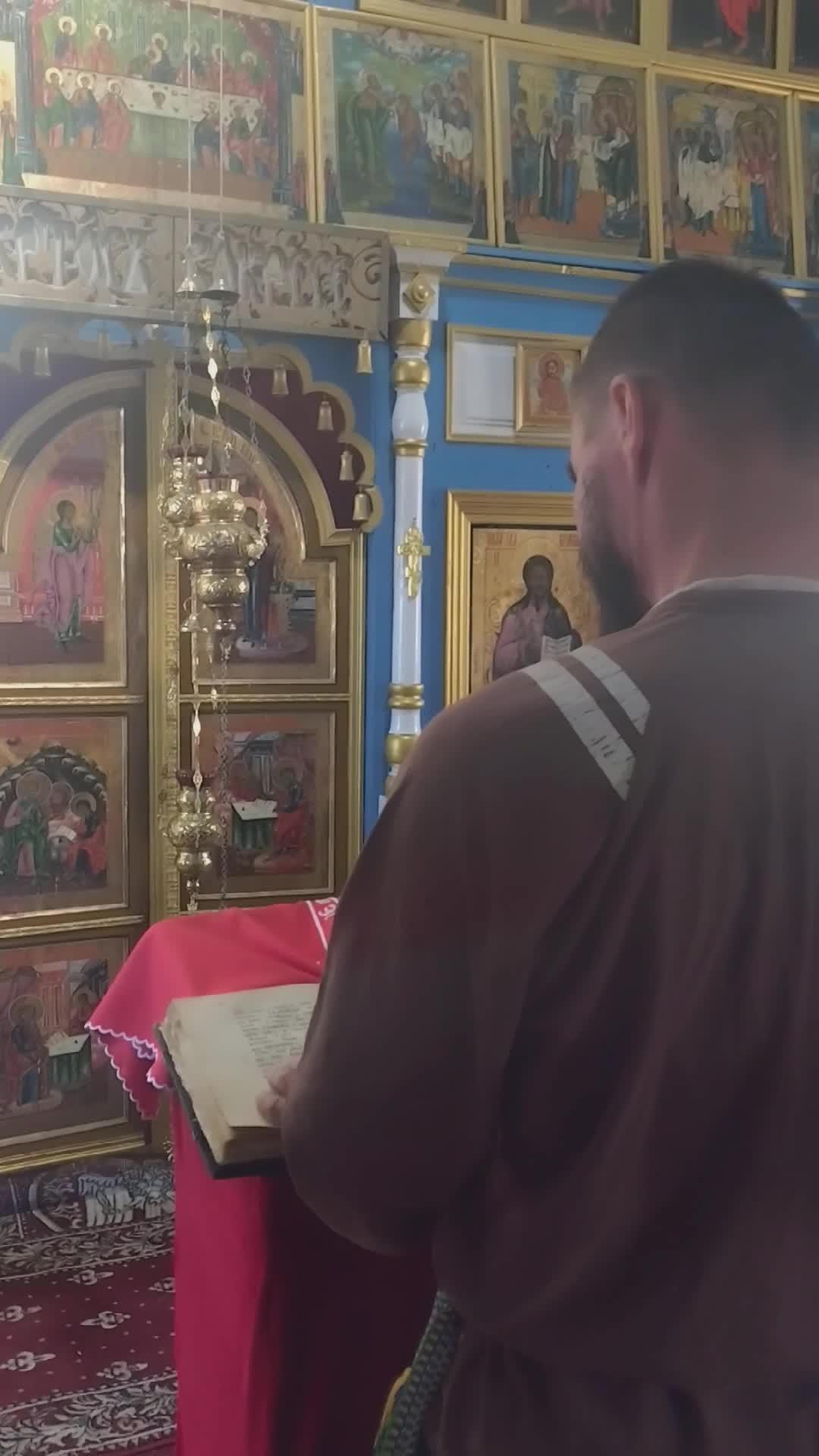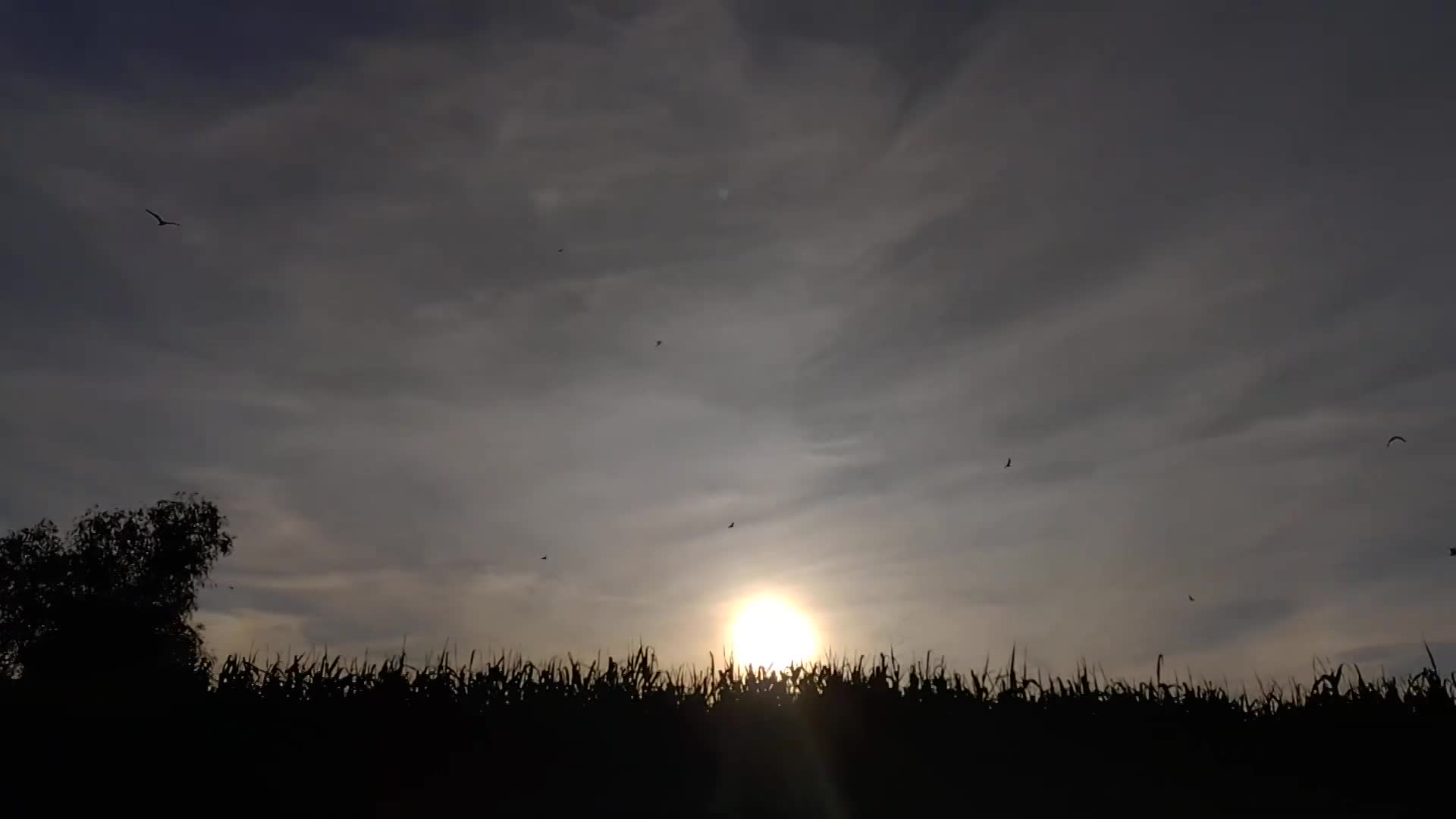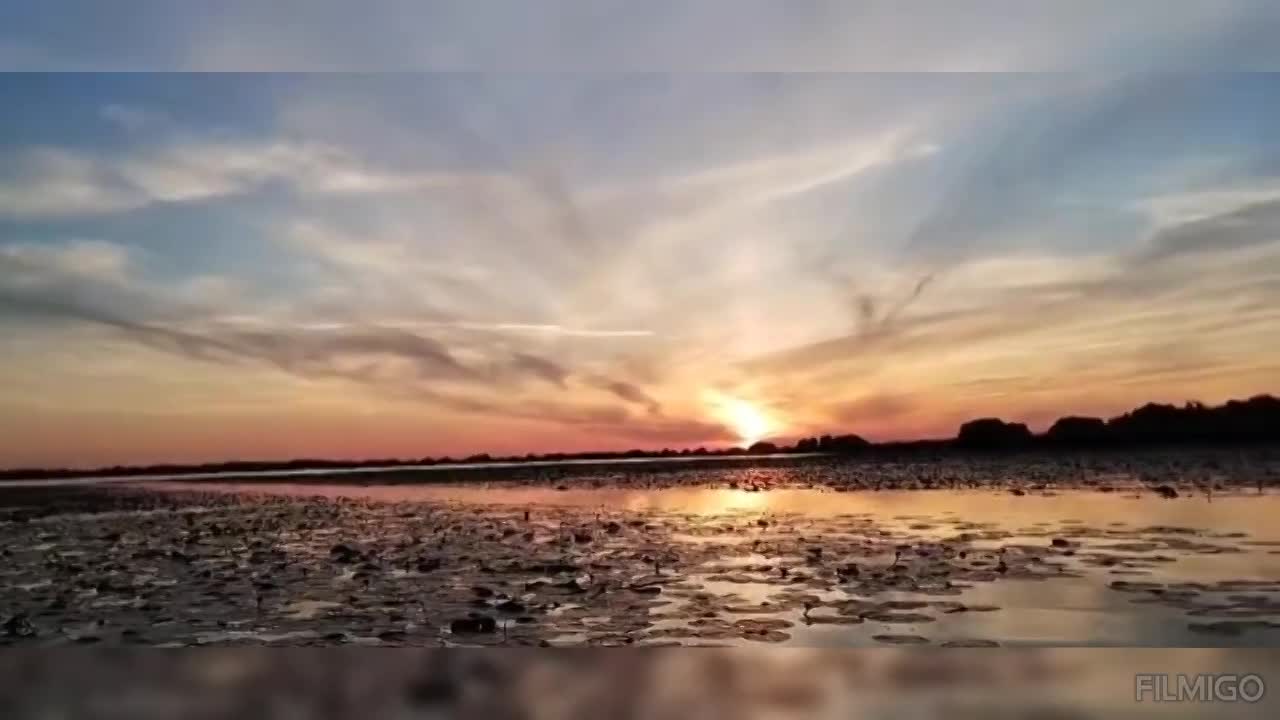Am cumpărat de pe net această mini-vacanță de două zile și jumătate la Mila 23, un mini-circuit cu excursii, ghid și demi-pensiune, organizat de descoperadeltadunarii.ro.
Ei zic că sunt 4 zile dar, de fapt, în prima zi se pleacă din Tulcea la ora 16, iar în ziua a patra se pleacă din Mila 23 la ora 9 dimineața - cu toate acestea, cele două zile și jumătate merită pe deplin și recomand acest sejur!
Delta Dunării a fost pentru mine un vis vechi și, pentru că e scump și se ajunge greu, l-am tot amânat; până acum. Deci... cu toții la bord!
We bought this two-and-a-half-day mini-vacation to Mila 23 online, a mini-tour with excursions, a guide, and half-board, organized by descoperadeltadunarii.ro.
They say it’s 4 days, but actually, on the first day, you depart from Tulcea at 4 PM, and on the fourth day, you leave Mila 23 at 9 AM - nevertheless, the two and a half days are fully worth it, and I recommend this trip!
The Danube Delta had been an old dream of mine, and because it’s expensive and hard to get to, I kept postponing it; until now. So... all aboard!
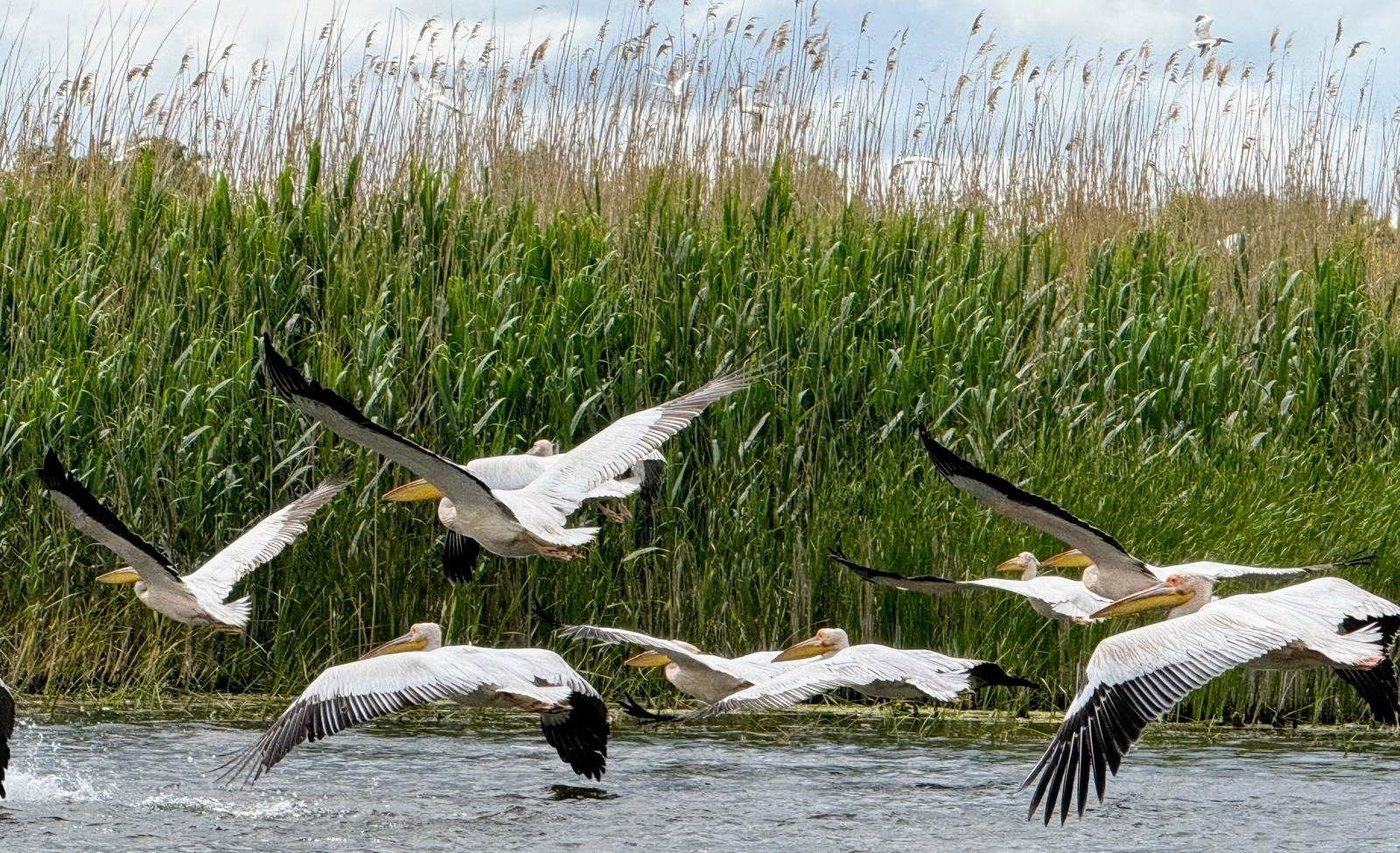
Vedetele Deltei: Pelicani comuni în zbor (Pelecanus onocrotalus) // The stars of the Delta: Common pelicans in flight (Pelecanus onocrotalus)
Ziua 1. Ne-am îmbarcat către Mila 23 pe la ora 16, din Portul Aval. Am fost 8 oameni care am plecat la drum în această frumoasă excursie. Ghidul nostru, Iulian, ne-a preluat din port și ne-a echipat cu veste de siguranță și cu informații esențiale înainte de a pleca la drum (precum faptul că, pe canalul Mila 35, sunt șanse mari să-ți intre roamingul ucrainean, astfel fiind mai indicat să-ți treci mobilul pe mod avion).
Day 1. We embarked for Mila 23 around 4 PM from Port Aval. There were 8 of us setting off on this beautiful excursion. Our guide, Iulian, picked us up from the port and equipped us with life jackets and essential information before departure (such as the fact that, on the Mila 35 canal, there is a high chance of Ukrainian roaming kicking in, so it’s better to switch your mobile to airplane mode).
Harta are straturi; selectați ziua din colțul din stânga sus // The map has layers; select the day from the upper left corner
Am plecat pe brațul Tulcea până la canalul Mila 35; la jumătatea distanței dintre Tulcea și locul unde brațul Tulcea se desprinde în brațul Sulina și brațul Sfântul Gheorghe, am făcut stânga pe canalul Mila 35 și ne-am continuat drumul, paralel la nord cu brațul Sulina, până la Mila 23.
We traveled on the Tulcea branch until Mila 35; halfway between Tulcea and the point where the Tulcea branch splits into the Sulina branch and the Sfântul Gheorghe branch, we turned left onto the Mila 35 canal and continued our journey, parallel to the north with the Sulina branch, until Mila 23.
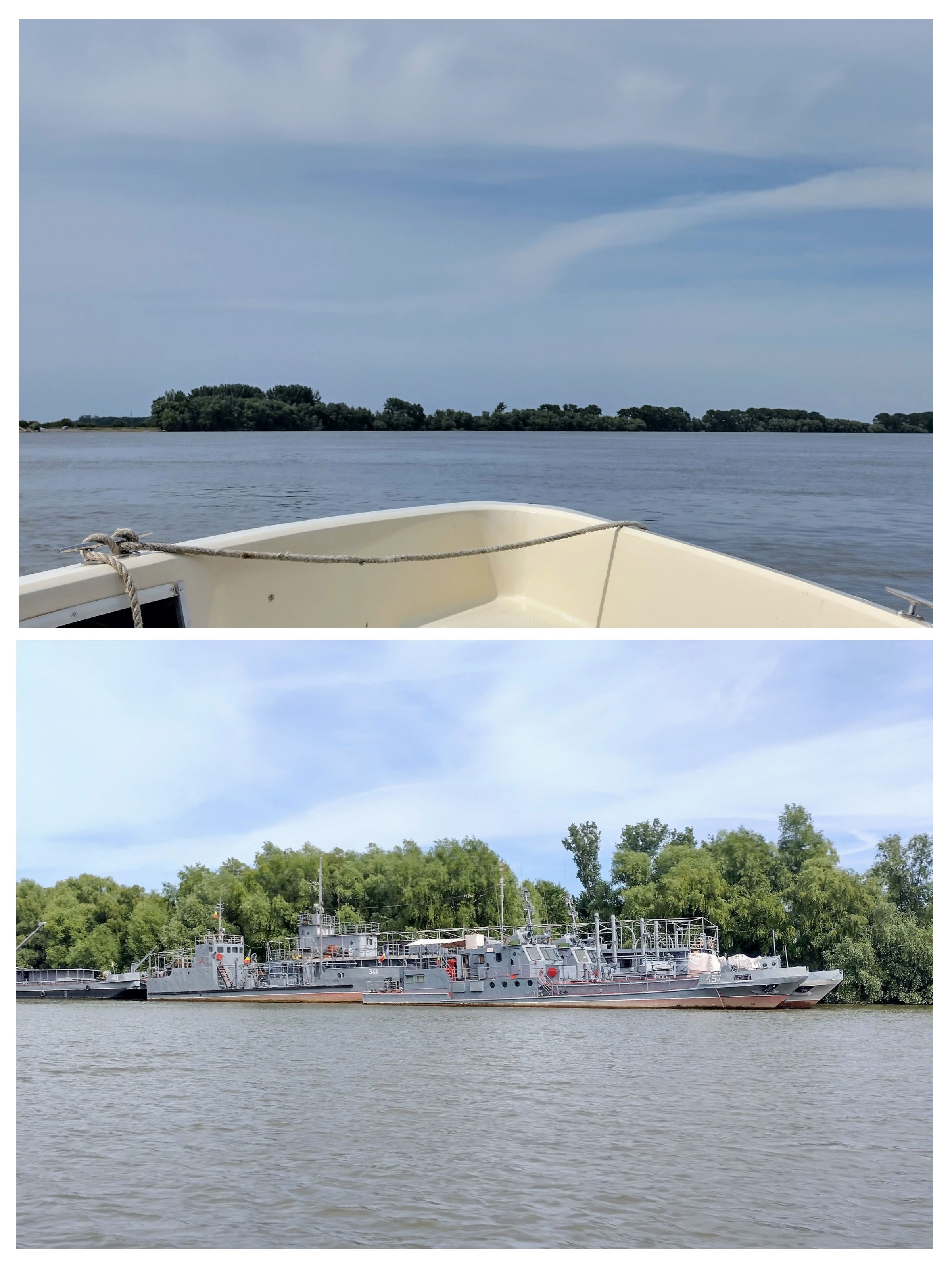
Bărci văzute din barcă // Boats seen from the boat
De cum am intrat pe canalul Mila 35, am început să vedem flora și fauna specifice Deltei: de la vița de vie sălbatică ce se agață de copacii mai înalți, la primele egrete ascunse printre crengile uscate căzute. Din canalul Mila 35 am făcut dreapta înspre gârla Șontea.
As soon as we entered the Mila 35 canal, we began to see the flora and fauna specific to the Delta: from wild grapevines clinging to the taller trees to the first egrets hidden among the fallen dry branches. From the Mila 35 canal, we turned right towards the Șontea channel.
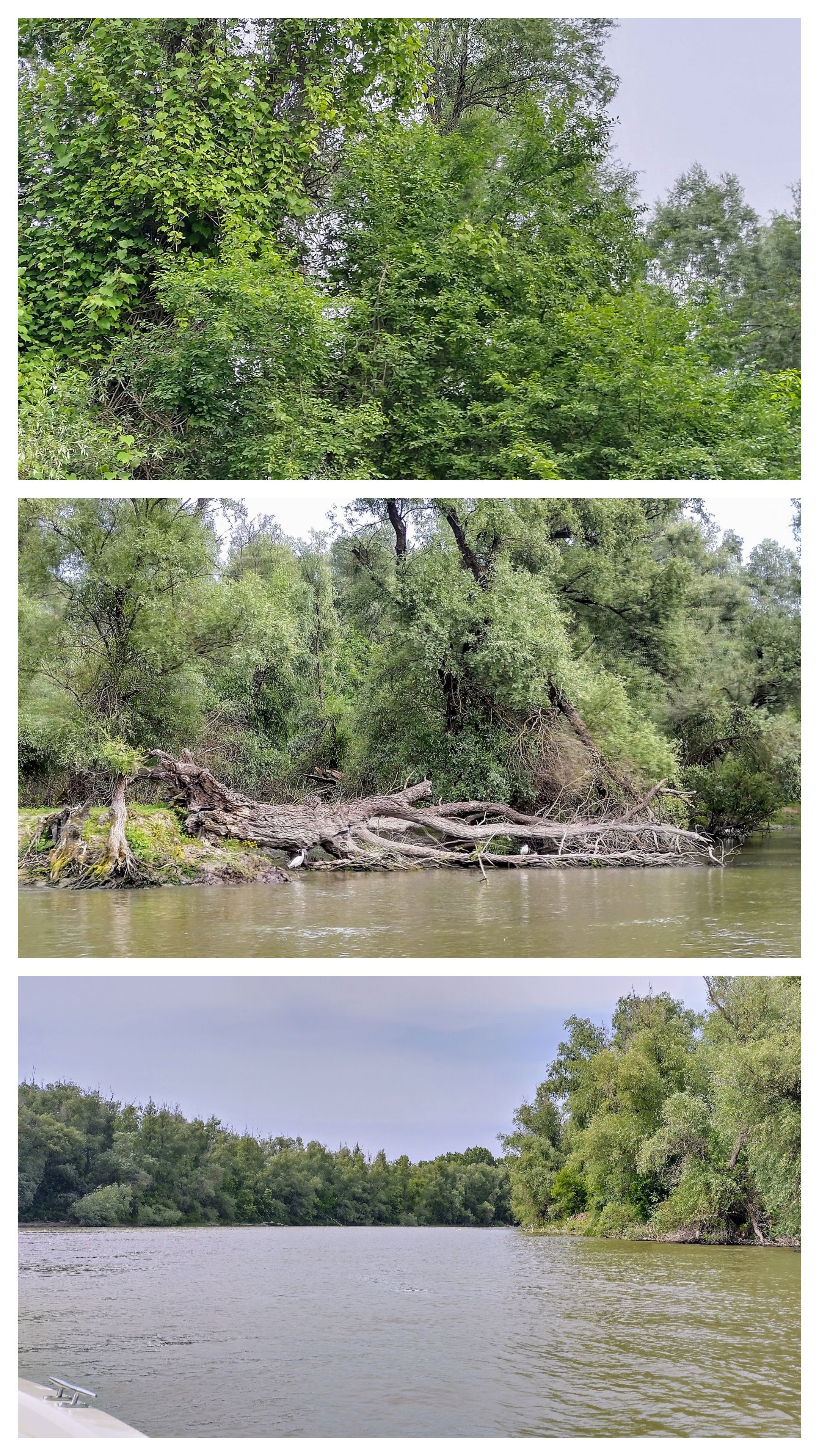
Viță de vie sălbatică (Vitis vinifera spp. Sylvestris); Egreta mică (Egretta garzetta); la cot spre Gârla Șontea // Wild grapevine (Vitis vinifera spp. Sylvestris); Little egret (Egretta garzetta); at the bend towards the Șontea Channel
De fapt, gârla Șontea se constituie din mai multe canale ce înconjoară, mai mult sau mai puțin, lacul Nebunu și lacul Băclăneștii Mari. Lacul Nebunu este o arie strict protejată, în care nu se poate pătrunde absolut deloc, pentru a nu deranja avifauna locală. Astfel, am pornit pe Șontea Nouă spre el și l-am ocolit prin nord, pe canalul Șontea Veche.
In fact, the Șontea channel consists of several canals that more or less surround Lake Nebunu and Lake Băclăneștii Mari. Lake Nebunu is a strictly protected area where entry is absolutely prohibited to avoid disturbing the local avifauna. Thus, we set off on Șontea Nouă towards it and circled it to the north, on the Șontea Veche canal.
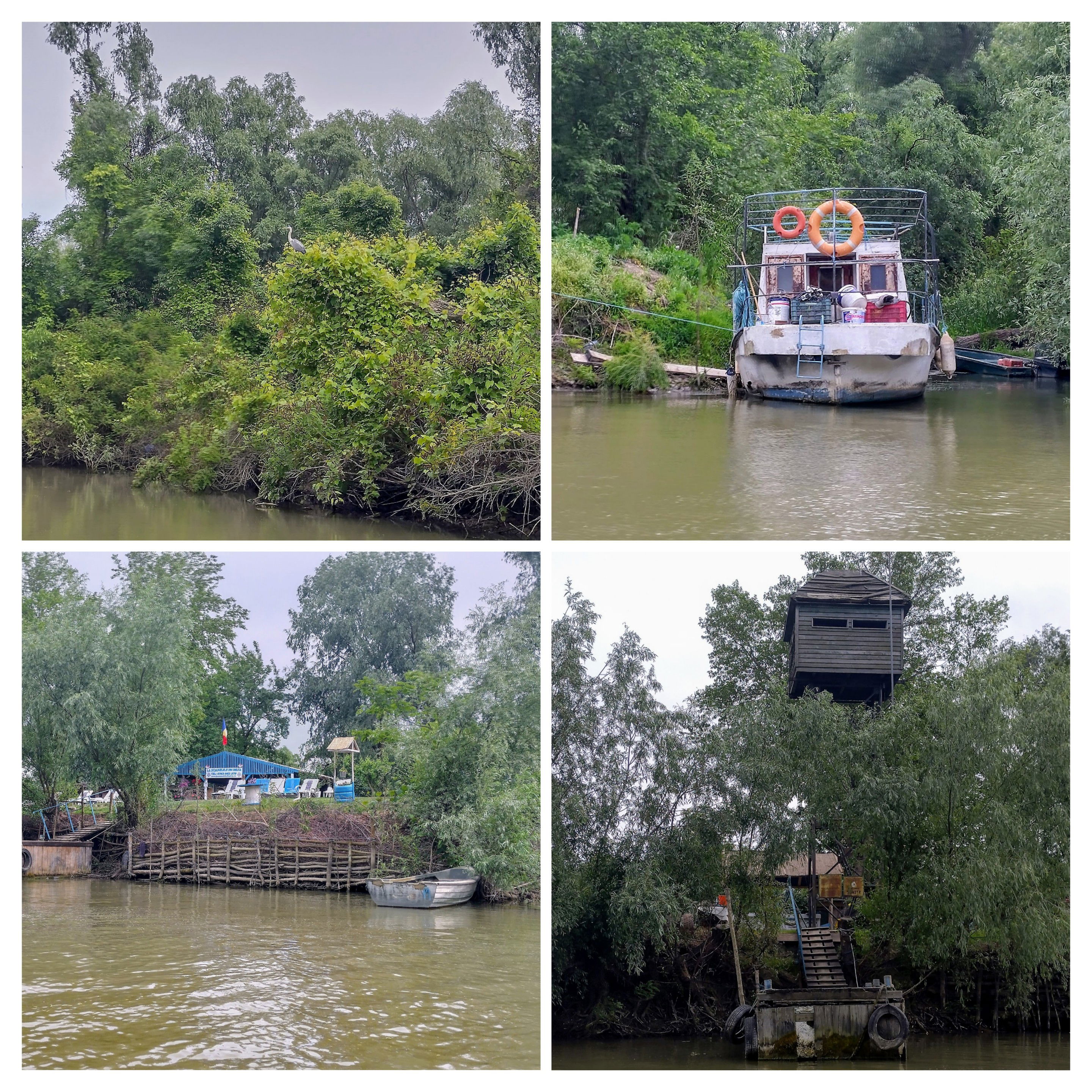
Stârcul cenușiu (Ardea cinerea); adăpostul pescăresc "La scaune" pe canalul Șontea Nouă // Grey heron (Ardea cinerea); the fishing shelter "La scaune", on the Șontea Nouă canal
Pe Șontea Veche am început să vedem păsări la modul mai serios, începând timid cu câțiva stârci galbeni ascunși prin stufăriș.
On Șontea Veche, we began to see birds more seriously, starting timidly with a few squacco herons hidden in the reeds.
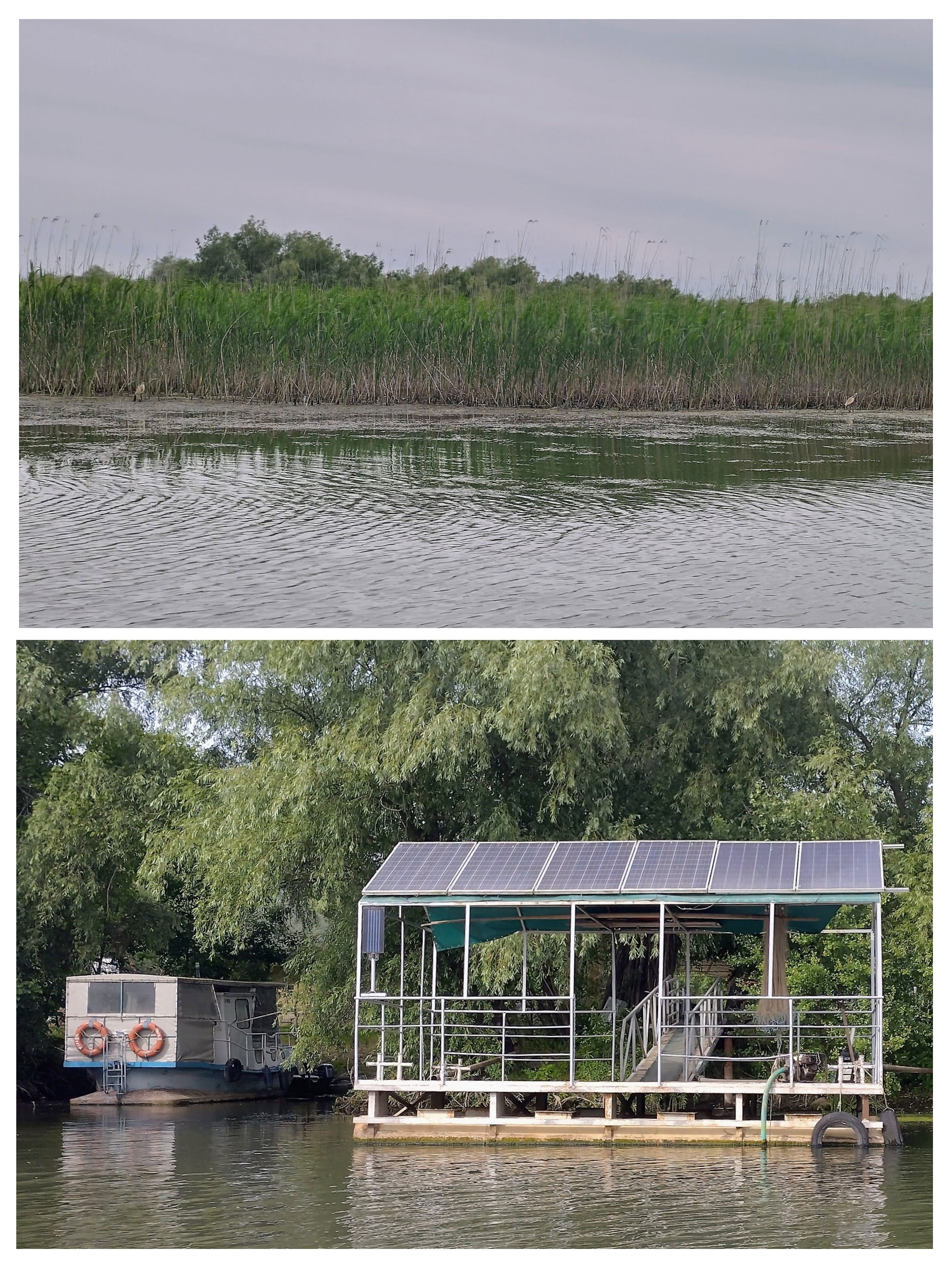
Stârcul galben (Ardeola ralloides); adăpostul pescăresc "La Nea Vasile și Simona" pe canalul Șontea Veche // Squacco heron (Ardeola ralloides); the fishing shelter "La Nea Vasile și Simona" on the Șontea Veche canal
Nu mult mai departe am văzut un cârd imens de pelicani comuni staționați pe mijlocul "drumului". Atât de mulți, s-a mirat și ghidul, este foarte rar să vezi. Trebuie că erau sute, dacă nu mii! Ieșiți, probabil, la masă, le-am "despicat" cârdul, navigând încet printre ei - ori se retrăgeau pe margini, ori își luau zborul, oferindu-ne astfel un spectacol 4DX chiar din prima zi de Deltă!
Not much further we saw an immense flock of common pelicans stationed in the middle of "the road." So many, even the guide was amazed, it is very rare to see. There must have been hundreds, if not thousands! Probably out for a meal, we "split" the flock, slowly navigating through them - they either retreated to the edges or took flight, offering us a 4DX spectacle right from the first day in the Delta!
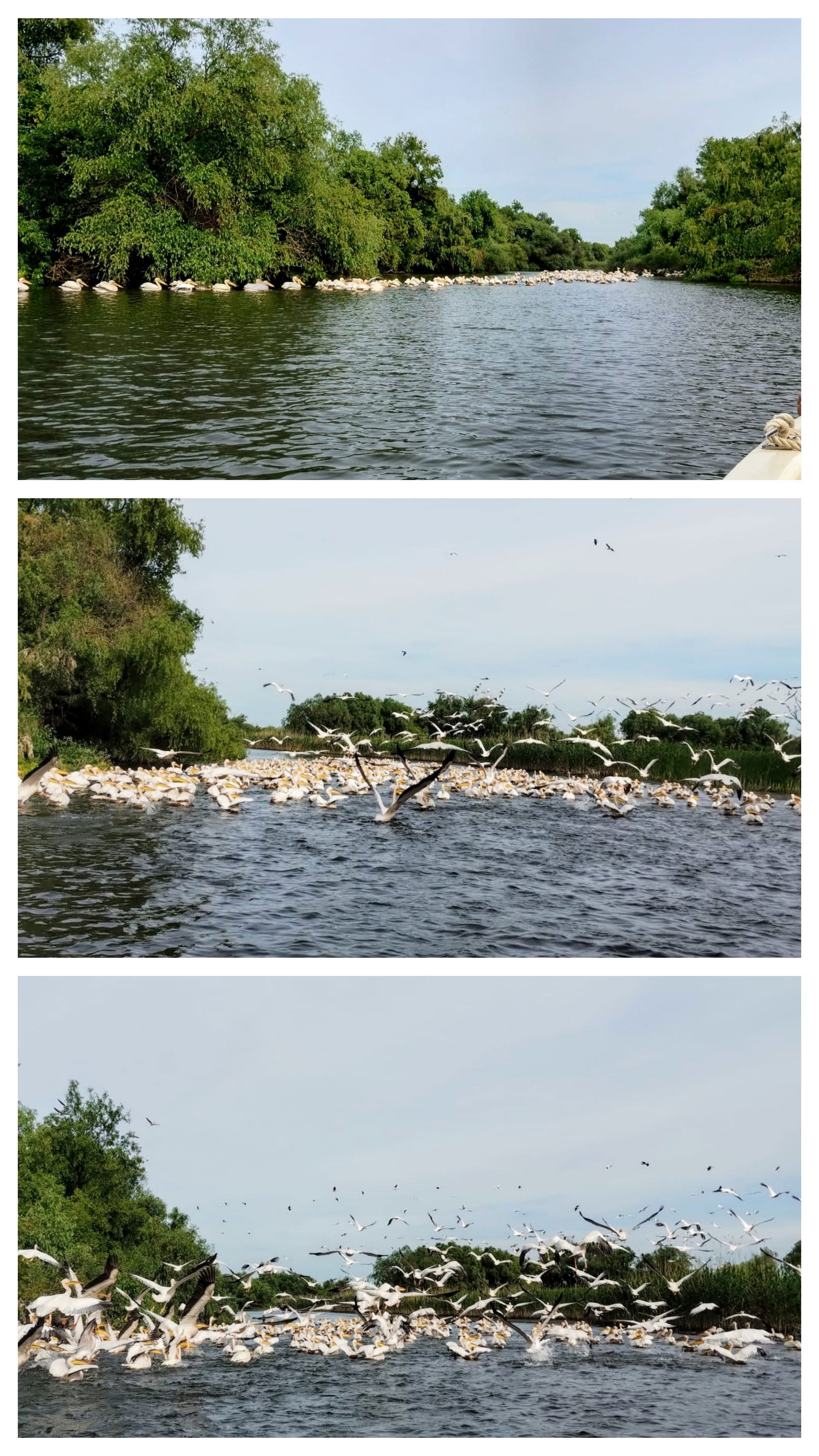
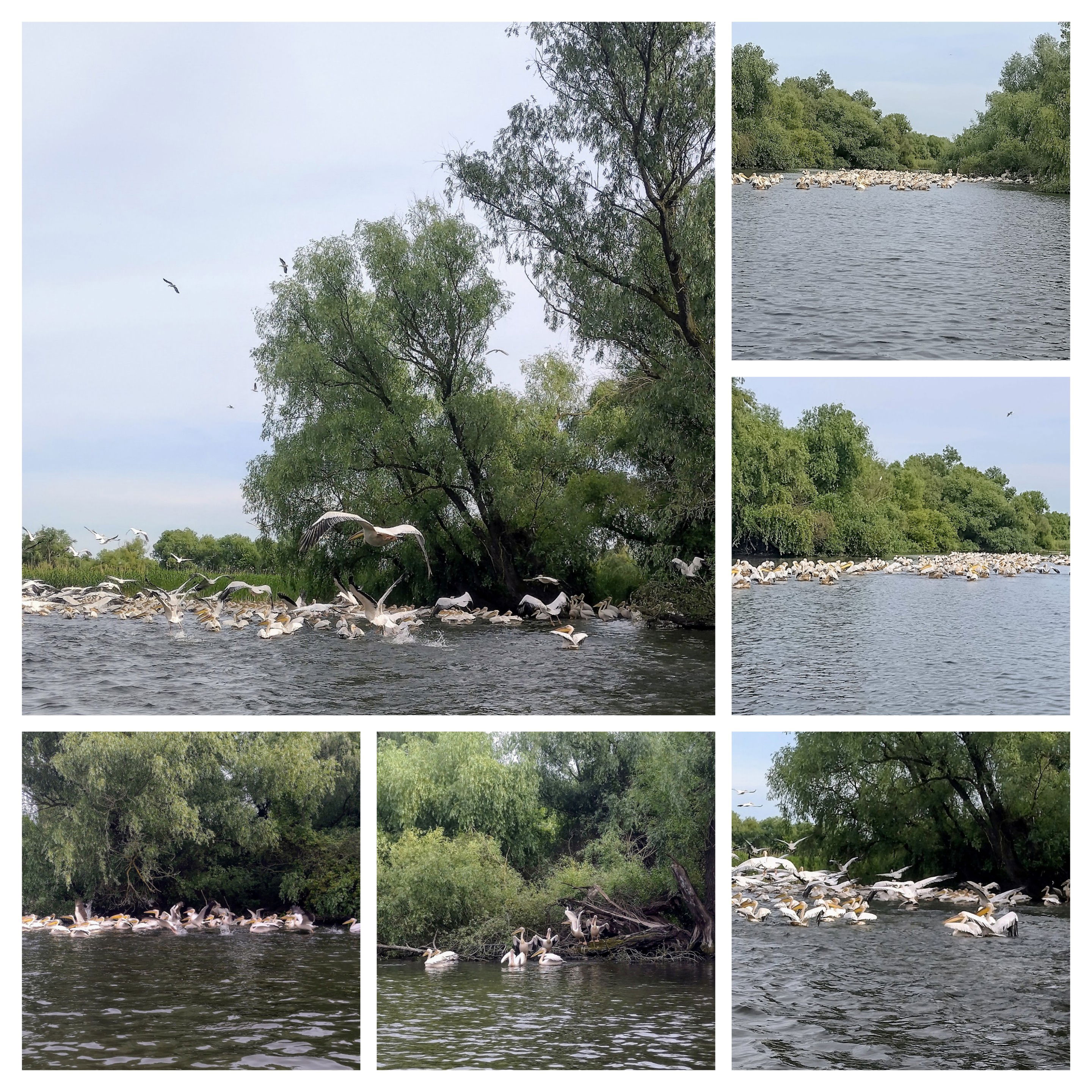
Pelicani decolând; în zbor, cormorani // Pelicans taking off; in flight, cormorants
Veniți la prăduit, masa abandonată pe fugă de pelicani a atras și cormoranii, care au un apetit nestăvilit cauzat de acidul gastric foarte concentrat, fiind considerați dăunători.
Coming to scavenge, the meal abandoned in a hurry by the pelicans also attracted the cormorants, which have an insatiable appetite caused by highly concentrated stomach acid, being considered pests.
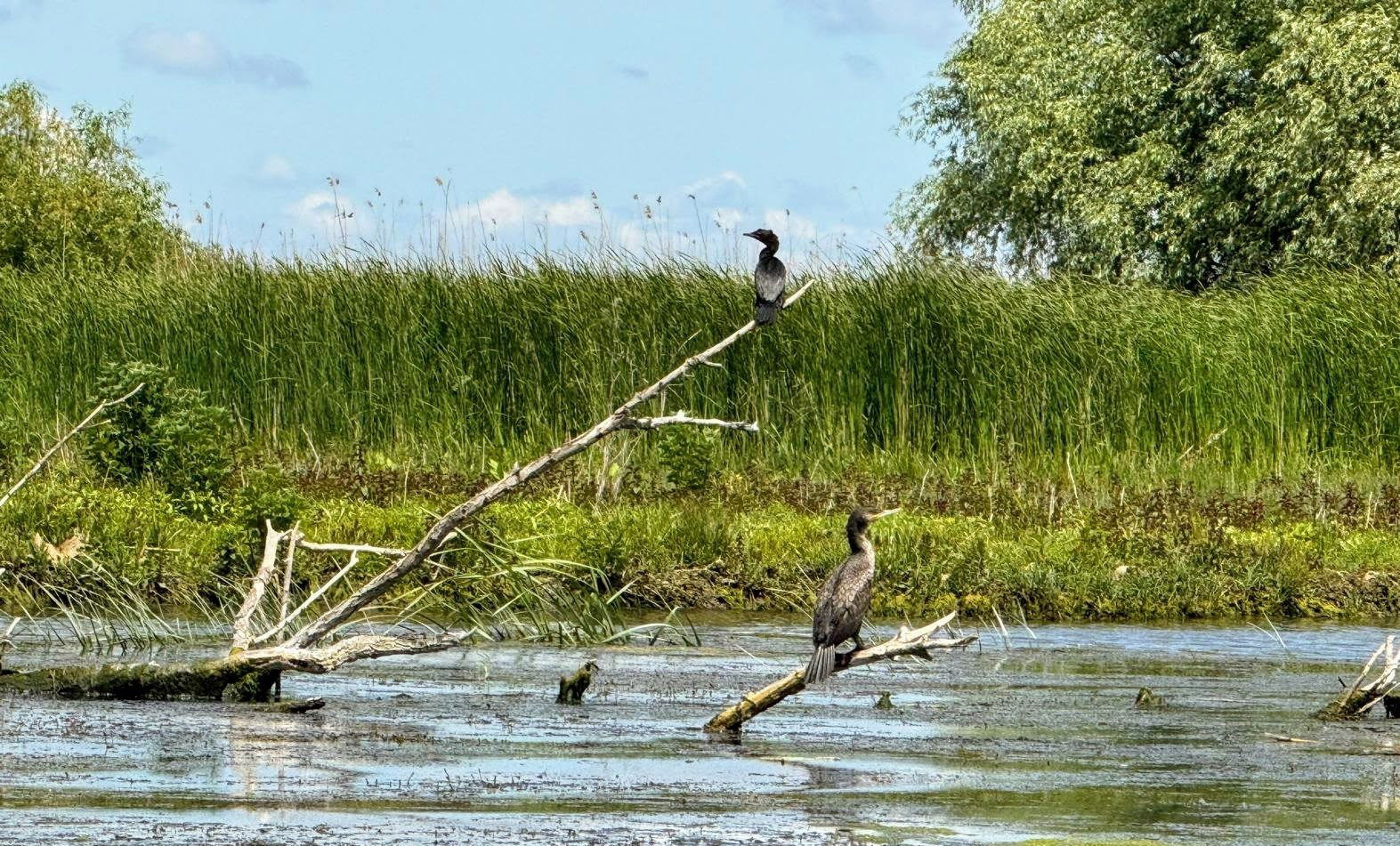
Cormoranul mare (Phalacrocorax carbo) // The Great cormorant (Phalacrocorax carbo)
Nici nu am înaintat prea departe, că am dat și de un lebădoi protectiv care, credeți-mă când vă spun, ferea niște pui de văzul nostru. Cel puțin pe cameră nu am reușit să prind nicio "dovadă" - cu adevărat eficient acest tată-elicopter!
We hadn't gone far when we encountered a protective swan that, believe me when I say, was hiding some chicks from our view. At least on camera, I couldn't capture any "evidence" - this helicopter dad was truly effective!
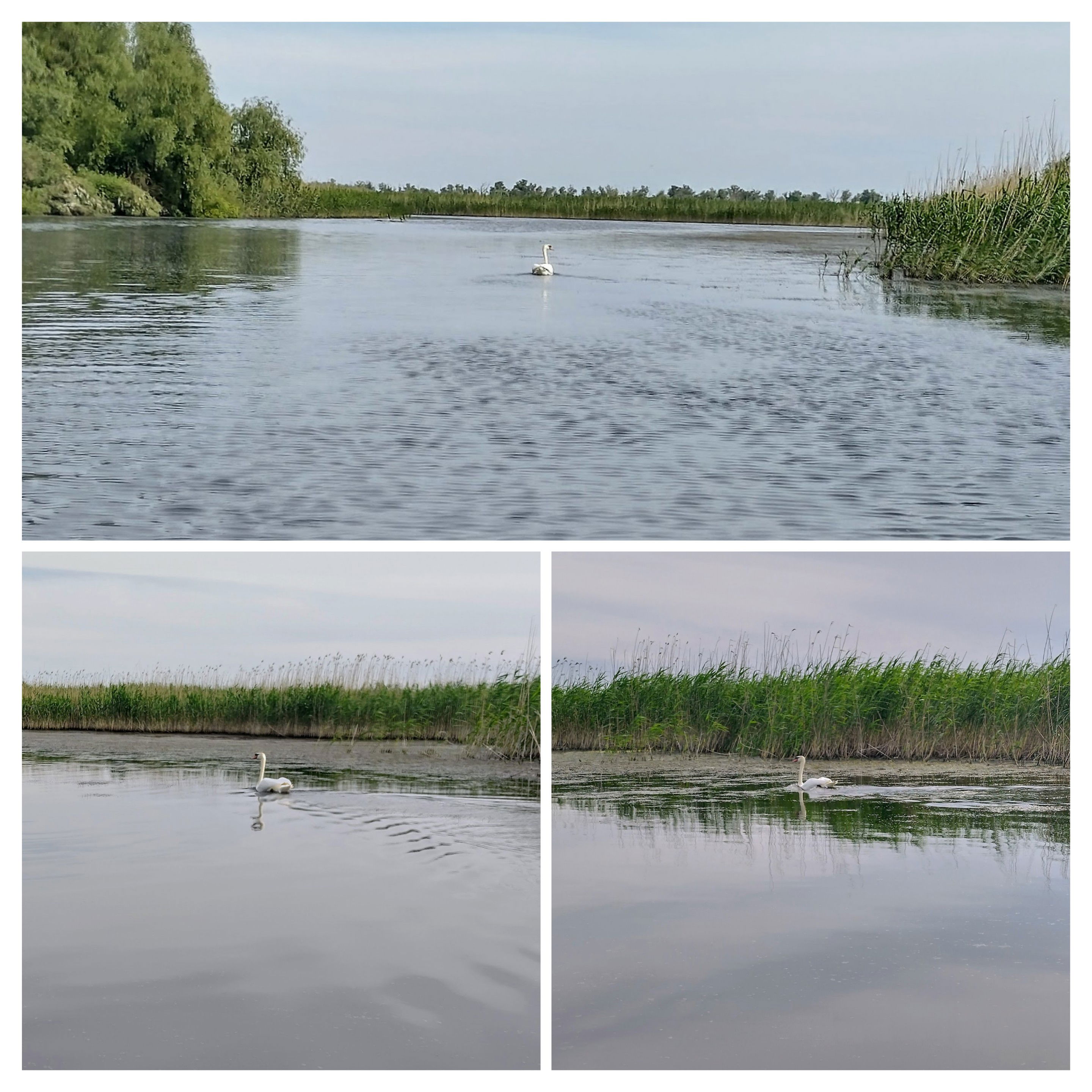
Lebăda de vară (Cygnus olor) // Mute swan (Cygnus olor)
Am văzut și sediul "celui mai vechi partid din lume" și apoi am urmat cursul canalului la Cot Candura și am intrat pe lacul Băclăneștii Mari.
We saw the headquarters of "the oldest party in the world" and then we followed the course of the canal to Cot Candura and entered Lake Băclăneștii Mari.
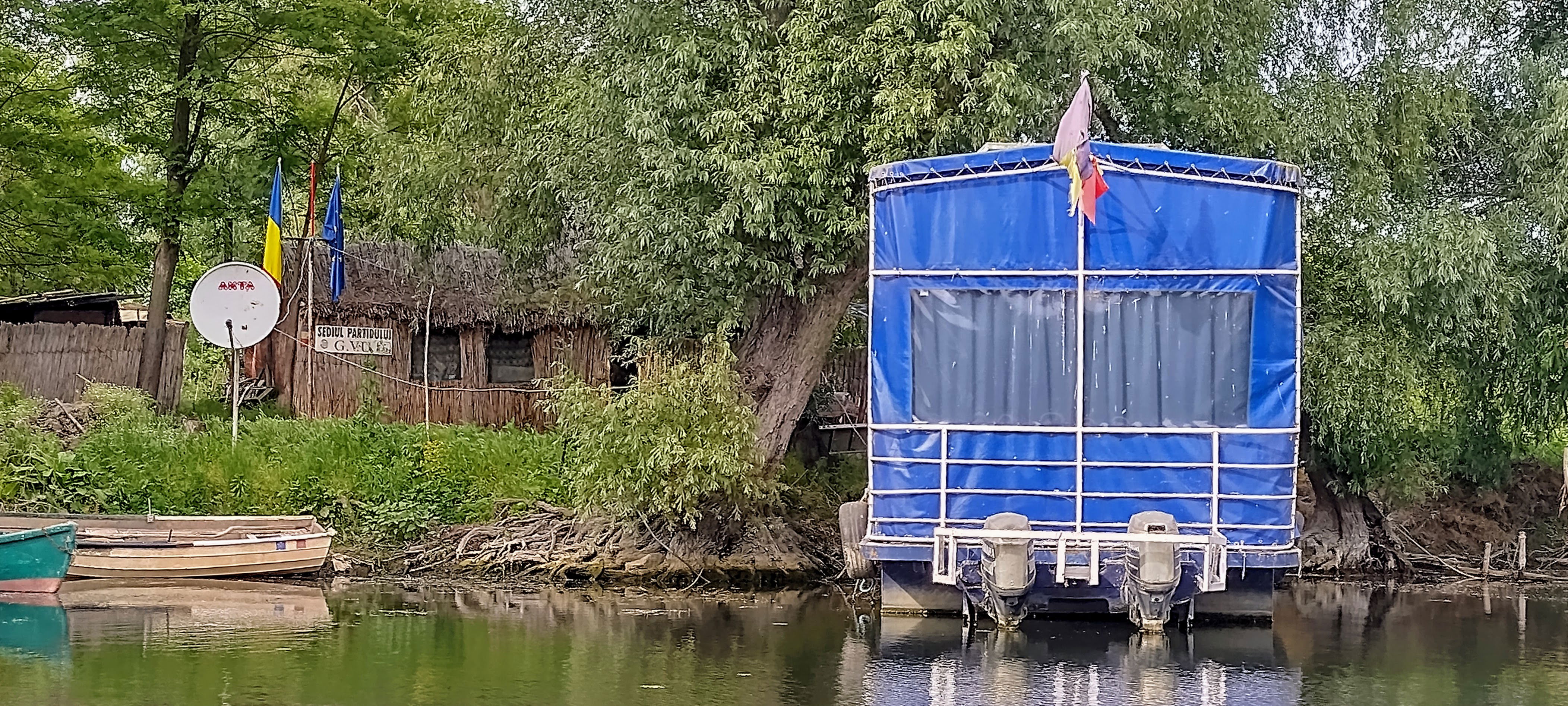
Sediul Partidului GVU (Gâtlejul Veșnic Ud), sau "La Babacu-n Deltă" // The headquarters of the EWT Party (The Eternally Wet Throat), or "La Babacu-n Deltă"
Lacurile din Deltă, acesta nefacând excepție, mustesc de viață, iar vegetația densă poate pune probleme bărcii noastre, astfel că, pe lacuri, ne-am deplasat rapid (atunci când n-am avut motiv să staționăm) - gândiți-vă la o mașină pe nisip, zăpadă sau noroi, mai bine să nu aștepți să te împotmolești și să nu tot oprești și pornești.
The lakes in the Delta, this one being no exception, teem with life, and the dense vegetation can cause problems for our boat, so on the lakes, we moved quickly (when we had no reason to stop) - think of a car on sand, snow, or mud, it's better not to wait to get stuck and not to keep stopping and starting.
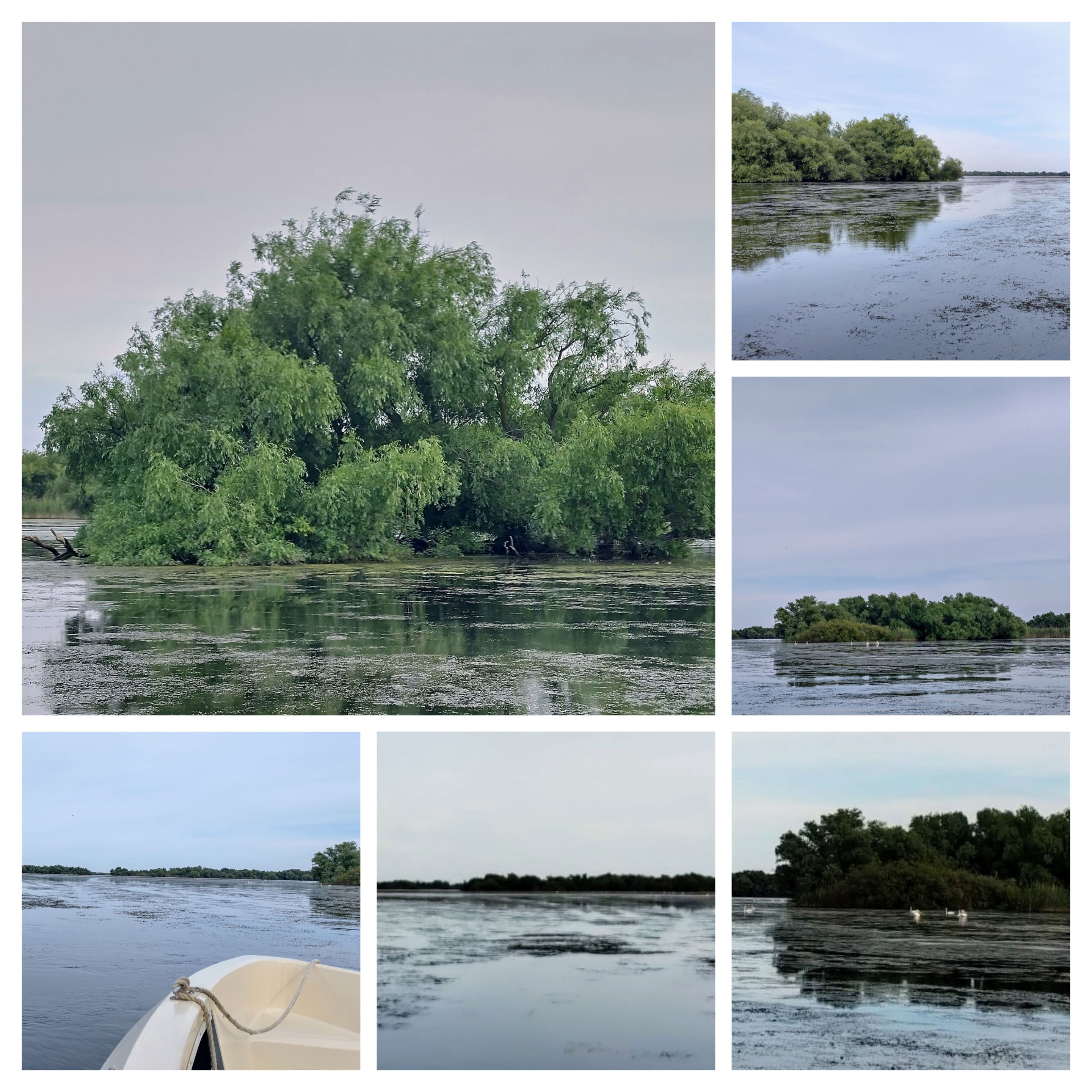
Lacul Băclăneștii Mari // The Băclăneștii Mari Lake
După acest lac, brațele Șontei se reîntâlnesc, și curând gârla Șontea întâlnește canalul antropic Olguța (numit așa în cinstea unei bătrâne care a ajutat la săparea lui).
After this lake, the branches of the Șontea meet again, and soon the Șontea channel meets the artificial Olguța canal (named in honor of an old woman who helped dig it).
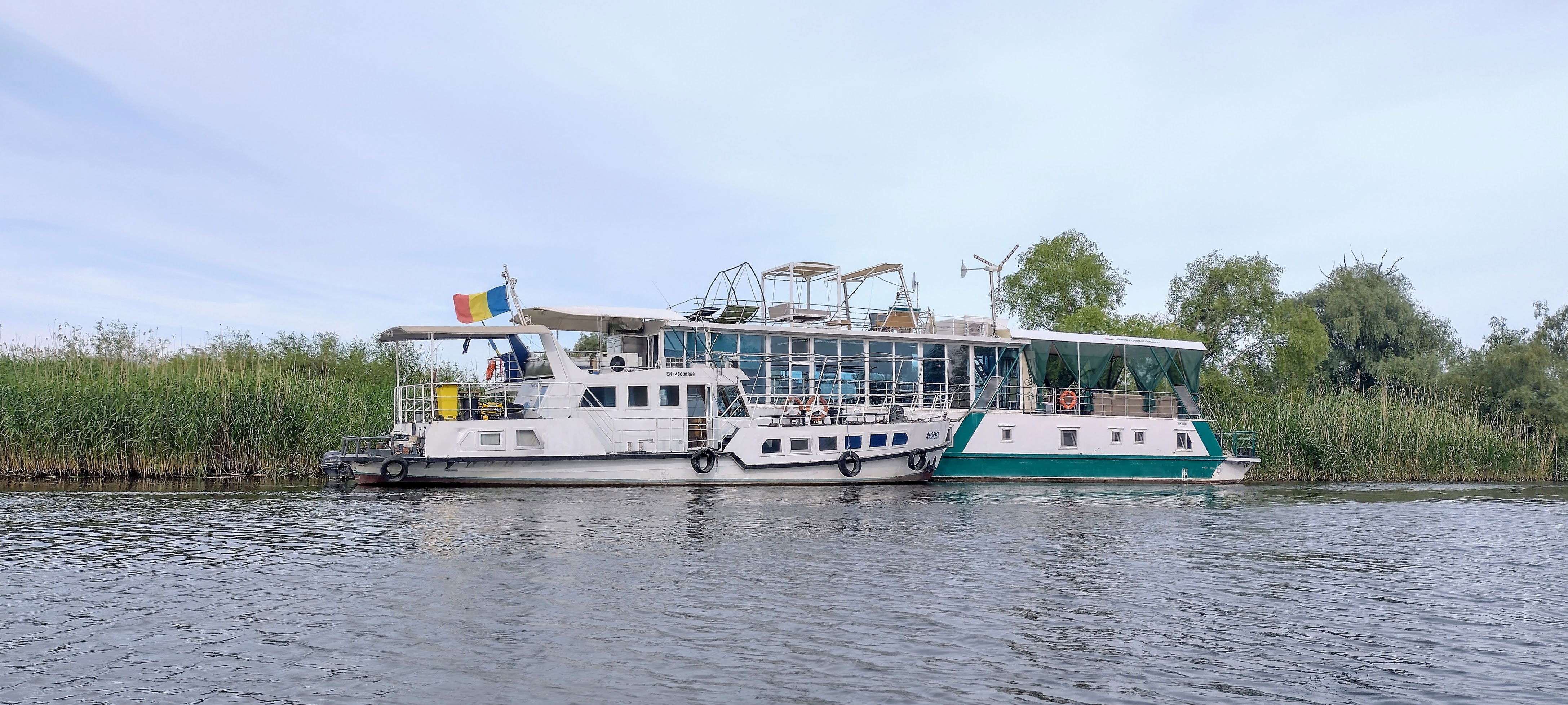
Ambarcațiune și hotel plutitor pe gârla Șontea // Boat and floating hotel on the Șontea Channel
Unde se face cotul mare pentru a ajunge la Mila 23, am intrat pe canalul Dunărea Veche. Imediat au început să apară micuțele case din Mila 23, dar și nou-construitul Muzeu al lui Ivan Patzaichin. Acesta urma să se inaugureze la câteva zile după plecarea noastră, și i-am prins pe meșteri făcând ultimele pregătiri, dar și dându-ne un sneak-peek la ce se va putea vizita. Din nefericire, de data asta nu l-am putut vizita, dar rămâne pentru viitor!
Where the big bend is made to reach Mila 23, we entered the Old Danube canal. Immediately, the small houses of Mila 23 began to appear, as well as the newly constructed Ivan Patzaichin Museum. This was to be inaugurated a few days after our departure, and we caught the craftsmen making the final preparations, but also giving us a sneak peek at what could be visited. Unfortunately, this time we couldn't visit it, but it remains for the future!

Mila 23 văzută de pe apă: Muzeul Ivan Patzaichin, pontonul "La Gemene", pontonul "Alexandru și Alexandra" // Mila 23 seen from the water: The Ivan Patzaichin Museum, the pontoon "La Gemene", the pontoon "Alexandru and Alexandra"
Ivan Patzaichin (1949 - 2021) a fost o legendă a canotajului românesc, cunoscut pentru realizările sale de neegalat în canotajul de viteză. Originar din Mila 23 în Delta Dunării, cariera lui Patzaichin s-a întins pe parcursul a peste două decenii, marcată de o dedicare extraordinară față de sport și o serie remarcabilă de victorii. Cele mai mari realizări ale sale includ câștigarea a patru medalii de aur olimpice și trei medalii de argint între 1968 și 1984, făcându-l unul dintre cei mai decorați canotori olimpici din istorie. Dominanța lui Patzaichin s-a extins și în afara Jocurilor Olimpice, câștigând numeroase titluri de Campionat Mondial și stabilind un standard de excelență care continuă să inspire generații de sportivi din întreaga lume.
Ivan Patzaichin (1949 - 2021) was a legendary Romanian canoeist renowned for his unparalleled achievements in sprint canoeing. Hailing from Mila 23 in the Danube Delta, Patzaichin's career spanned over two decades, marked by an extraordinary dedication to the sport and a remarkable series of victories. His greatest achievements include winning four Olympic gold medals and three silver medals between 1968 and 1984, making him one of the most decorated Olympic canoeists in history. Patzaichin's dominance extended beyond the Olympics, securing numerous World Championship titles and setting a standard of excellence that continues to inspire generations of athletes worldwide.
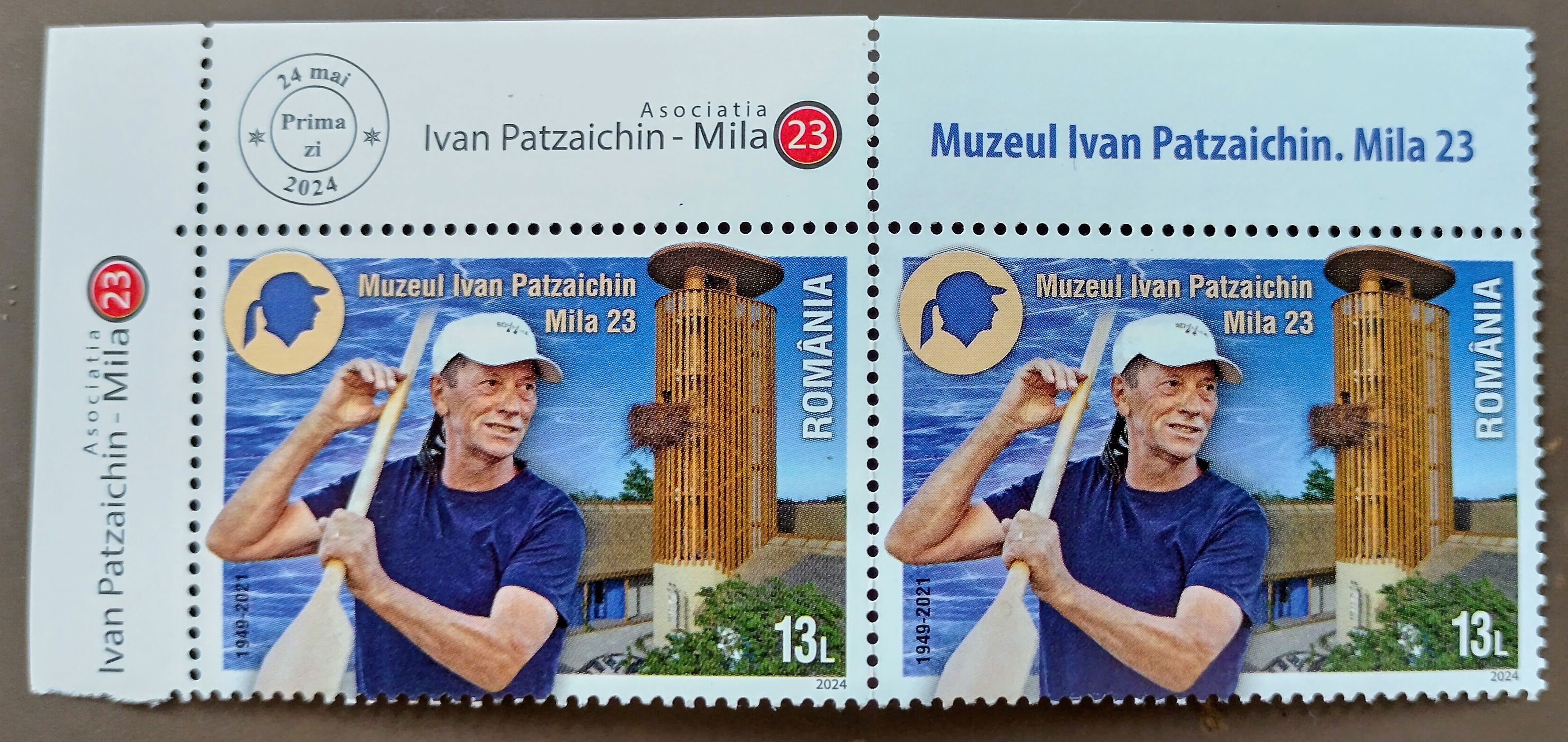
Emisiune de timbre cu Muzeul lui Ivan Patzaichin // Stamp issue featuring the Ivan Patzaichin Museum
La cină am luat și primul contact cu bucătăria deltaică: "carnivorii" au renunțat repede la pui (prea gras pentru gusturile orășenești) în favoarea peștelui, preparat de cele mai multe ori la cuptor (sau ciorbă), servit cu mămăligă, mujdei și ardei iute. Vegetarienii s-au delectat cu variațiuni la cuptor, precum dovlecel, cartofi sau ardei, dar și cu salate bune, nelipsita mămăligă cu mujdei și deserturi de casă.
At dinner, we also had our first contact with the Delta cuisine: the "carnivores" quickly gave up on chicken (too fatty for urban tastes) in favor of fish, mostly baked (or in soup), served with polenta, garlic sauce, and hot peppers. The vegetarians indulged in baked variations such as zucchini, potatoes, or peppers, as well as good salads, the inevitable polenta with garlic sauce, and homemade desserts.
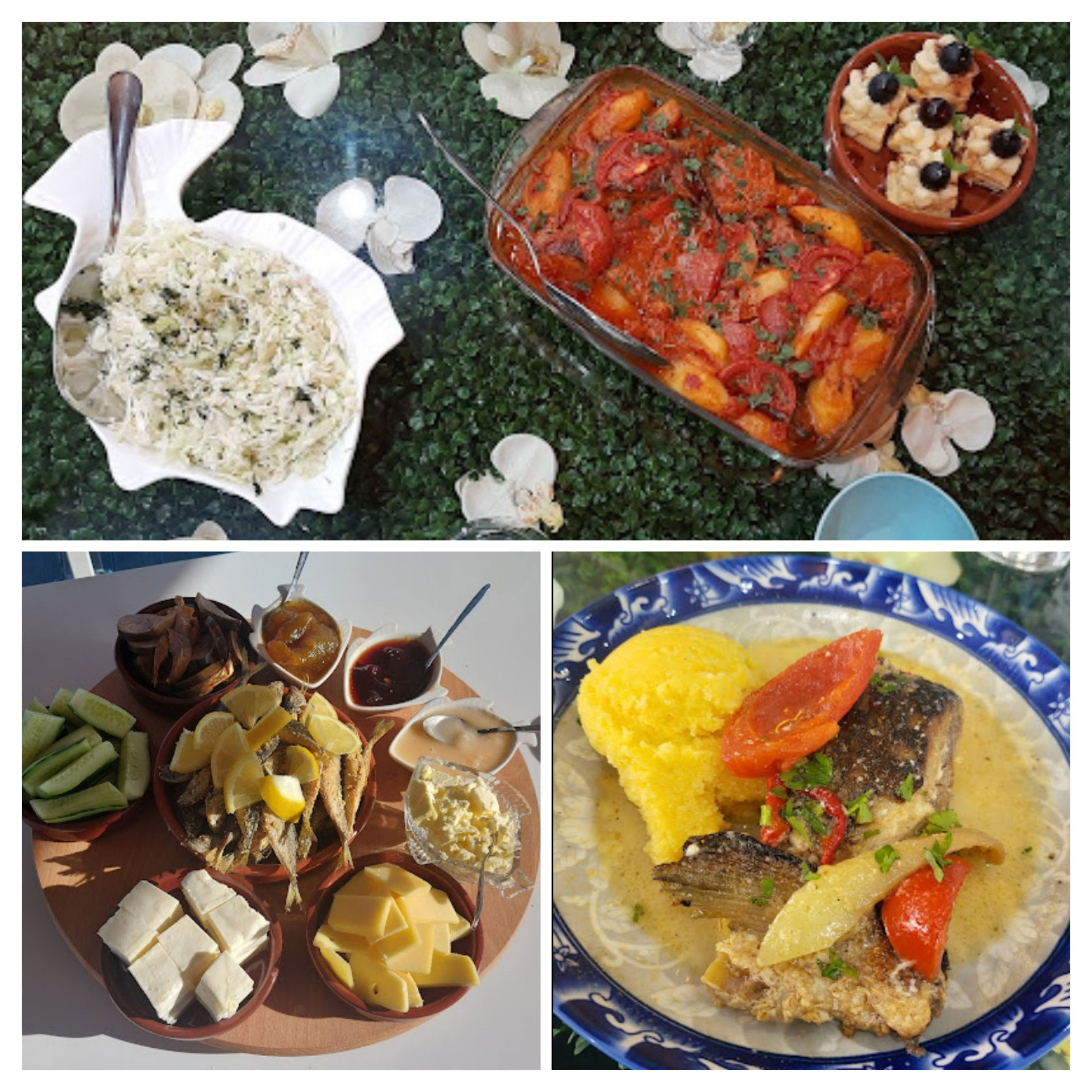
Cartofi la cuptor cu salată de varză și sandvișuri cu icre; platou mic-dejun; saramură de crap cu mămăligă // Baked potatoes with coleslaw and roe sandwiches; breakfast platter; Carp stew with polenta
Am ieșit apoi la o plimbare prin sat, unde am găsit magazinul principal, ulița de legătură între străzile paralele și niște vișine delicioase atârnând din curțile oamenilor. Se construiește în Mila 23, și poate că vom mai veni să vedem zona și peste câțiva ani.
We then went for a walk through the village, where we found the main store, the connecting alley between the parallel streets, and some delicious sour cherries hanging from the people's yards. Construction is ongoing in Mila 23, and perhaps we will come back to see the area in a few years.
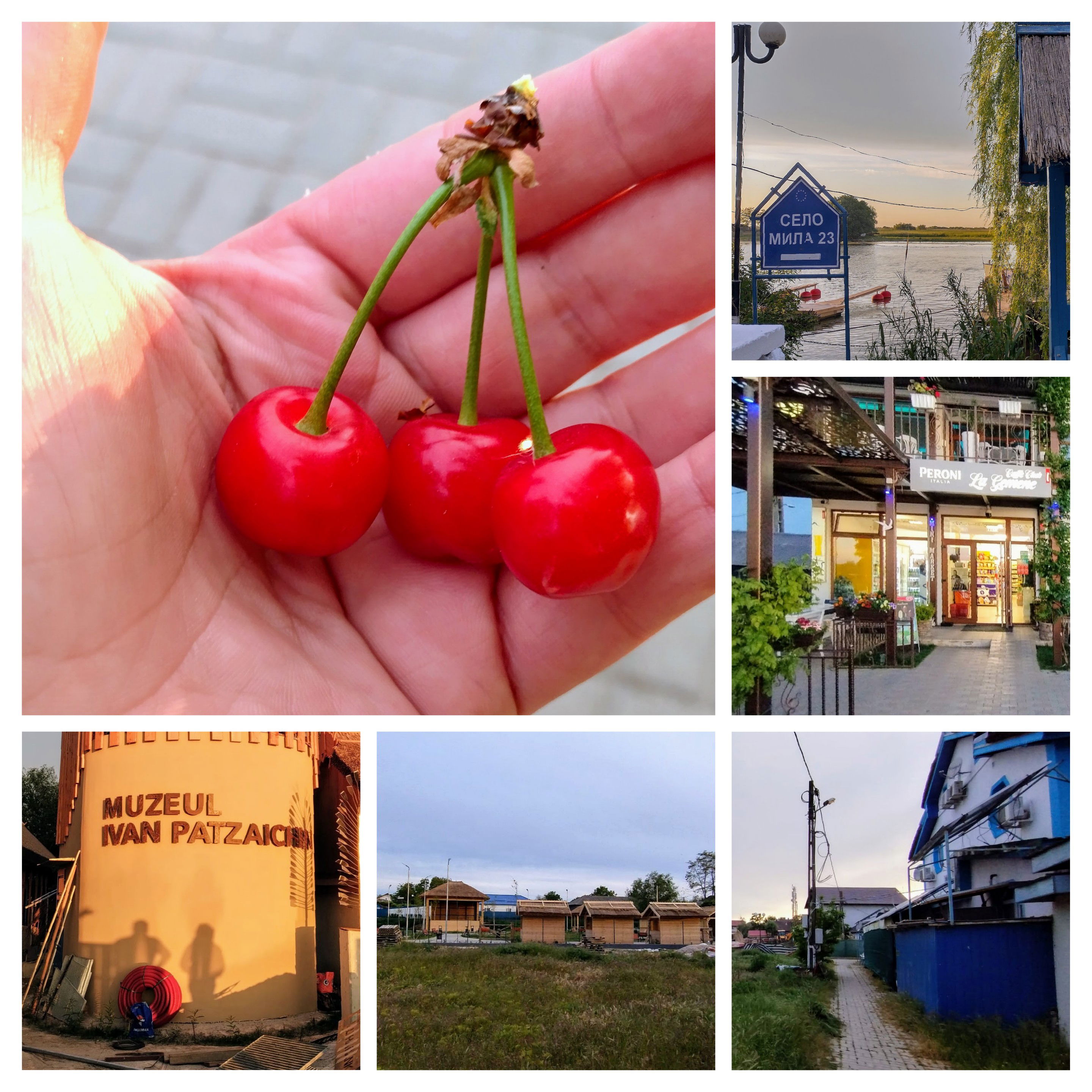
Ne-am întors pe strada din spate, care dă într-un canal artificial ce deservește casele din spatele satului.
We returned on the back street, which leads to an artificial canal that serves the houses at the back of the village.
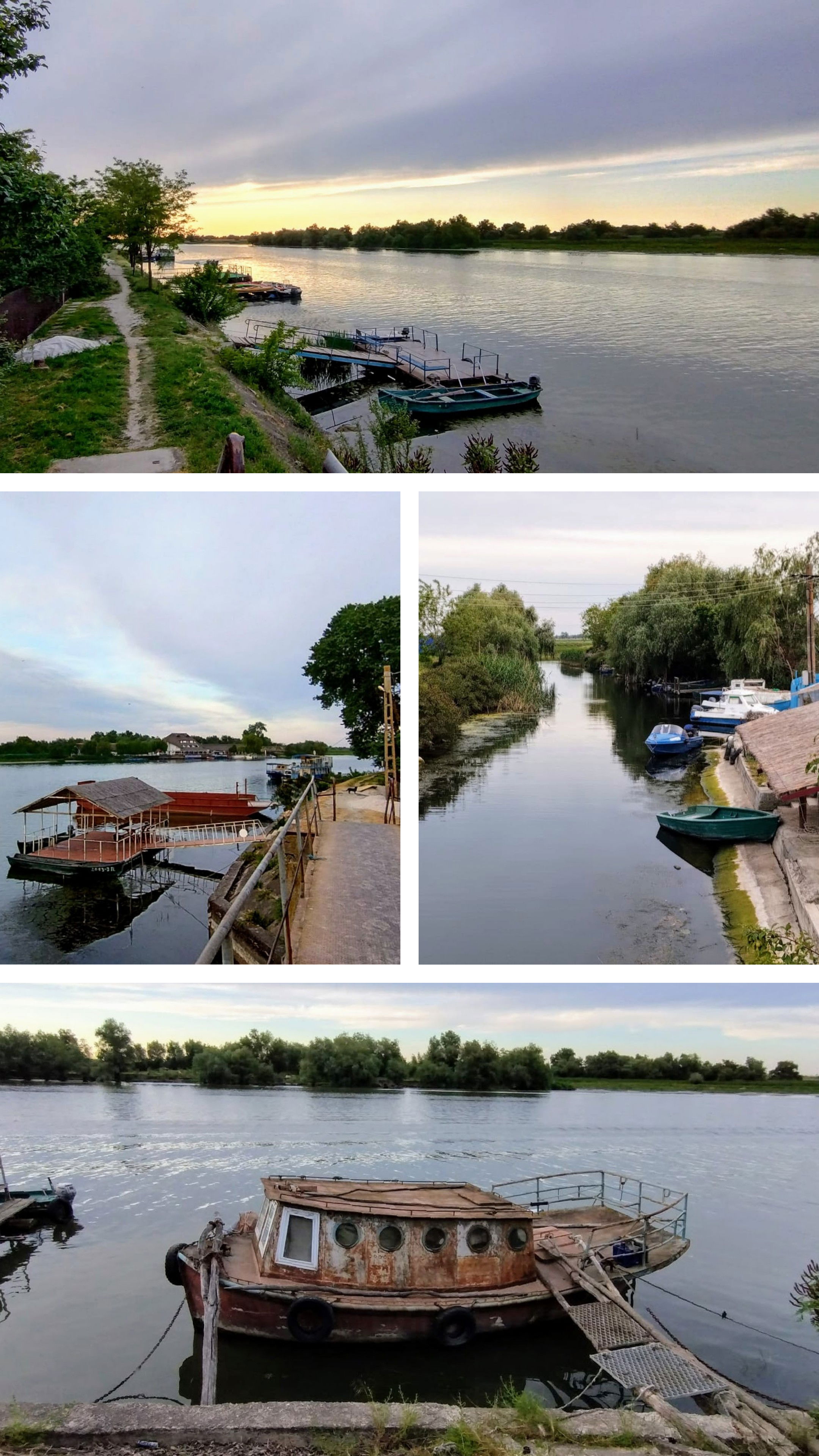
Ulița principală; podul peste canal; canalul interior; vestigii // Main street; bridge over the canal; inner canal; vestiges
Tot în interiorul satului am găsit și Biserica Lipovenească, pe care o vom vizita în ziua ce urmează; la colțul ei, an de an se întoarce această barză, de atâta vreme că lumea nici nu mai ține socoteala.
In the interior of the village we also found the Lipovan Church, which we will visit the next day; at its corner, this stork returns year after year, for so long that people no longer keep track.

Barză albă (Ciconia ciconia) // White stork (Ciconia ciconia)
Ocolind întreg satul întâi prin stânga, apoi prin dreapta, ne-am întors înspre cazare1 să admirăm și primul apus, magic, în Deltă.
1. https://tinyurl.com/3zr4tkhp
Skirting the entire village first to the left, then to the right, we returned to the accommodation1 to admire the first magical sunset in the Delta.
1. https://tinyurl.com/3zr4tkhp
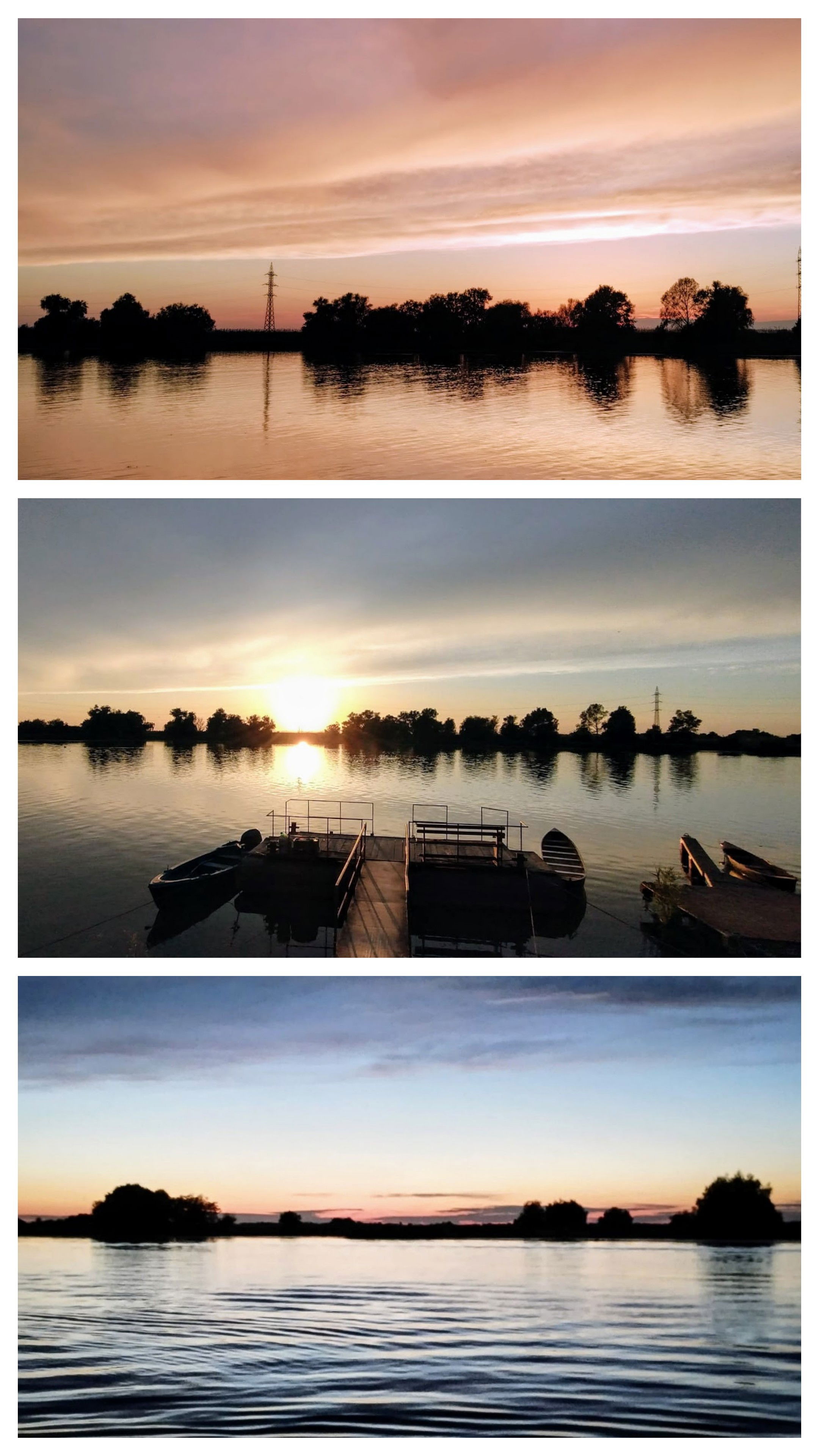
Ziua 2. A doua zi am început-o ca într-un roman fantastic, realizând vastitatea pustiului în care ne aflăm, dar și frumusețea sa.
Day 2. The next day began as if we were in a fantastic novel, realizing the vastness of the wilderness around us, yet also its beauty.
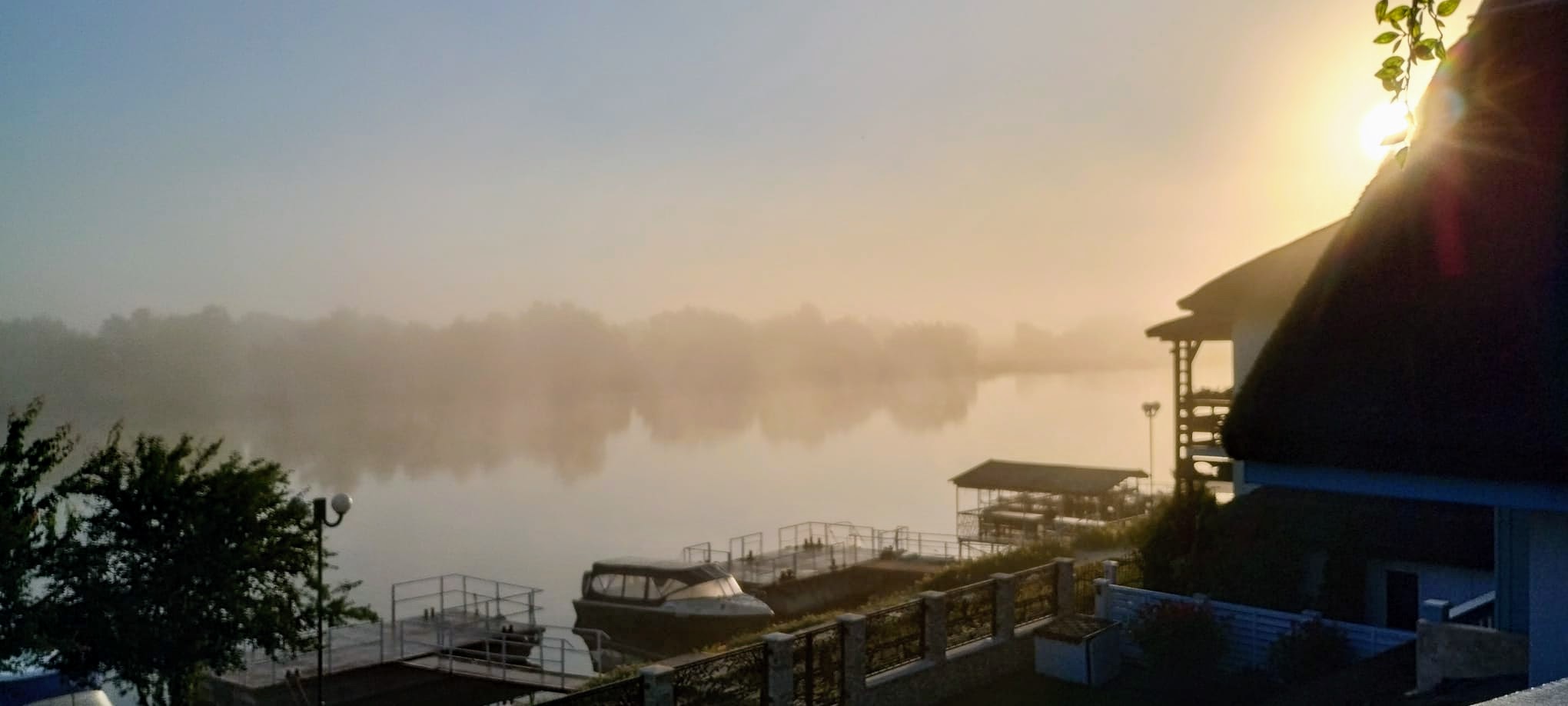
Un răsărit încețoșat // A foggy sunrise
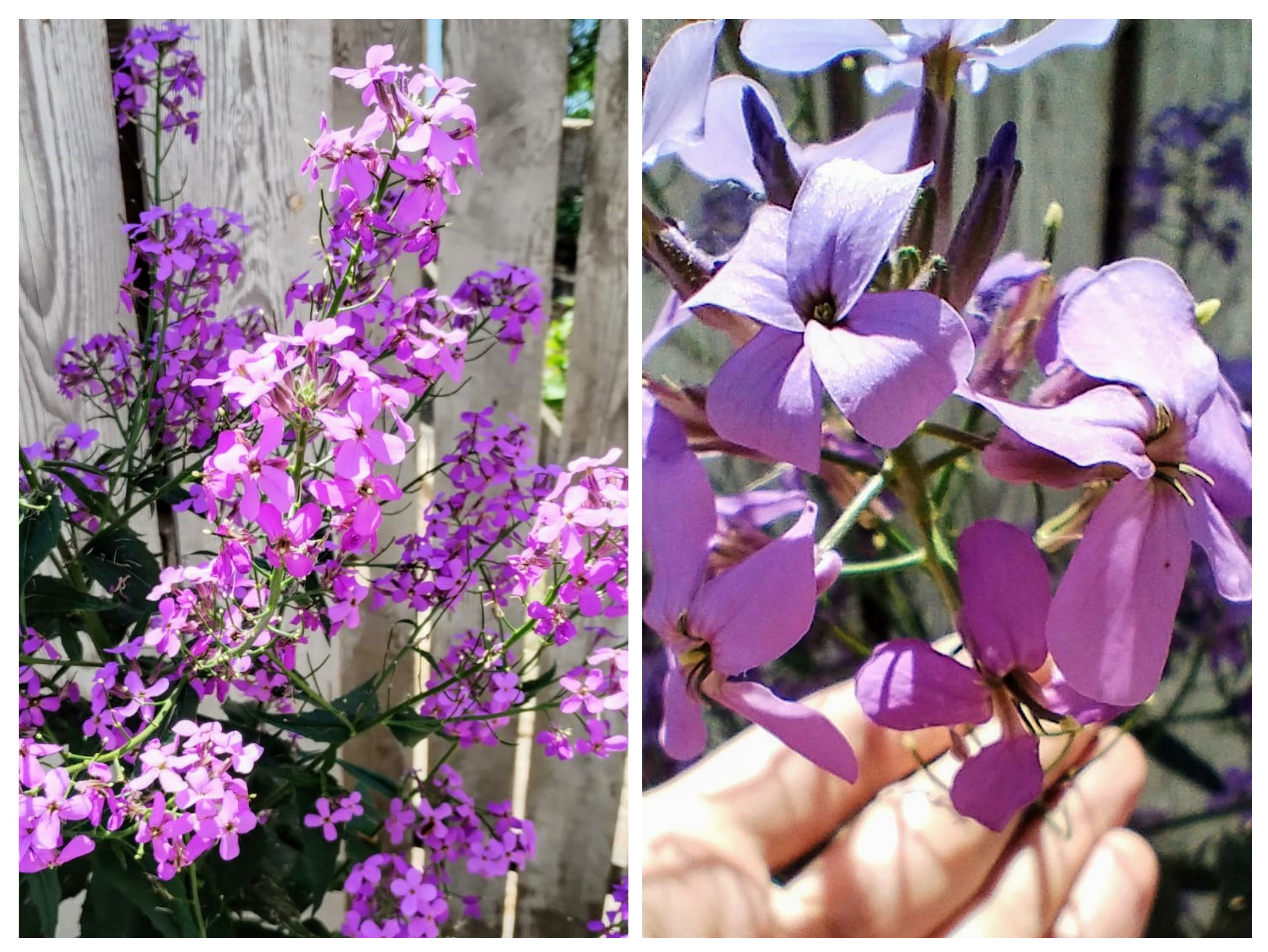
Violeta de noapte (Hesperis matronalis) // Dame's rocket (Hesperis matronalis)
Harta are straturi; selectați ziua din colțul din stânga sus // The map has layers; select the day from the upper left corner
Apoi, după micul dejun, am pornit în prima excursie de pe lacuri. Aveam să mai facem două, una după prânz și una la apus. Am ieșit din Mila 23 înspre partea dreaptă, pe canalul Eracle, urmând apoi canalul și lacul Rădăcinos.
Then, after breakfast, we set out on the first lake excursion. We were to take two more trips, one after lunch and one at sunset. We left Mila 23, heading to the right, onto the Eracle canal, then followed the canal and the Rădăcinos lake.
Rapid pe canalul Eracle // Fast on the Eracle canal
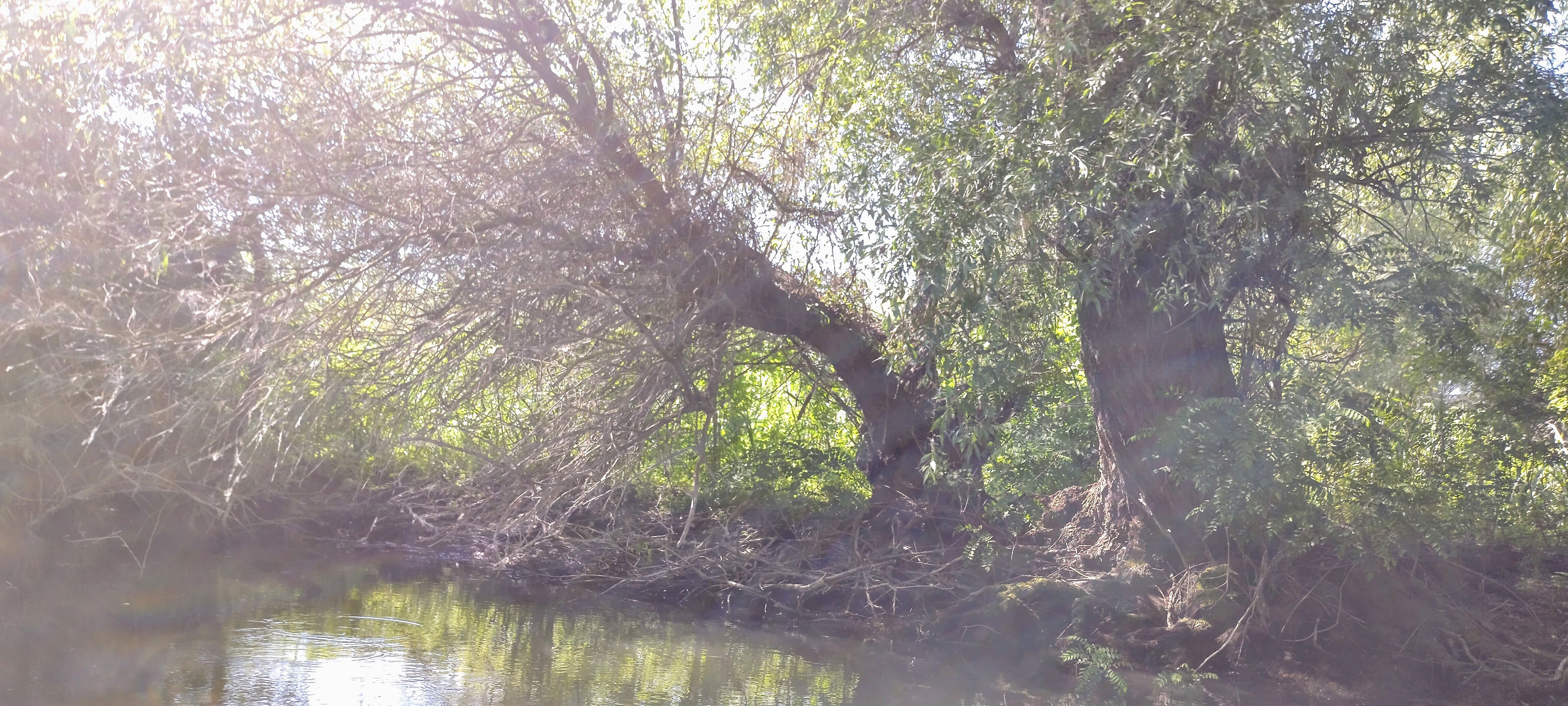
Canalul Rădăcinos, sau Brațliva // The Rădăcinos, or Brațliva canal
Aici am făcut și prima oprire, unde ne-am uitat mai îndeaproape la plantele de apă. Aici am învățat despre ciulinele de baltă, și am asistat și la matineul broaștelor, ascunse printre ciulini.
Din miezul ciulinilor de baltă, cunoscuți și drept castane de baltă, se face un piure pe care, însă, nu am avut ocazia să-l gustăm de data asta.
Here we made our first stop, where we took a closer look at the aquatic plants. We learned about water caltrops and attended the morning show of frogs hiding among the plants.
From the water caltrops, also known as water chestnuts, a puree is made, which we didn’t have the chance to taste this time.
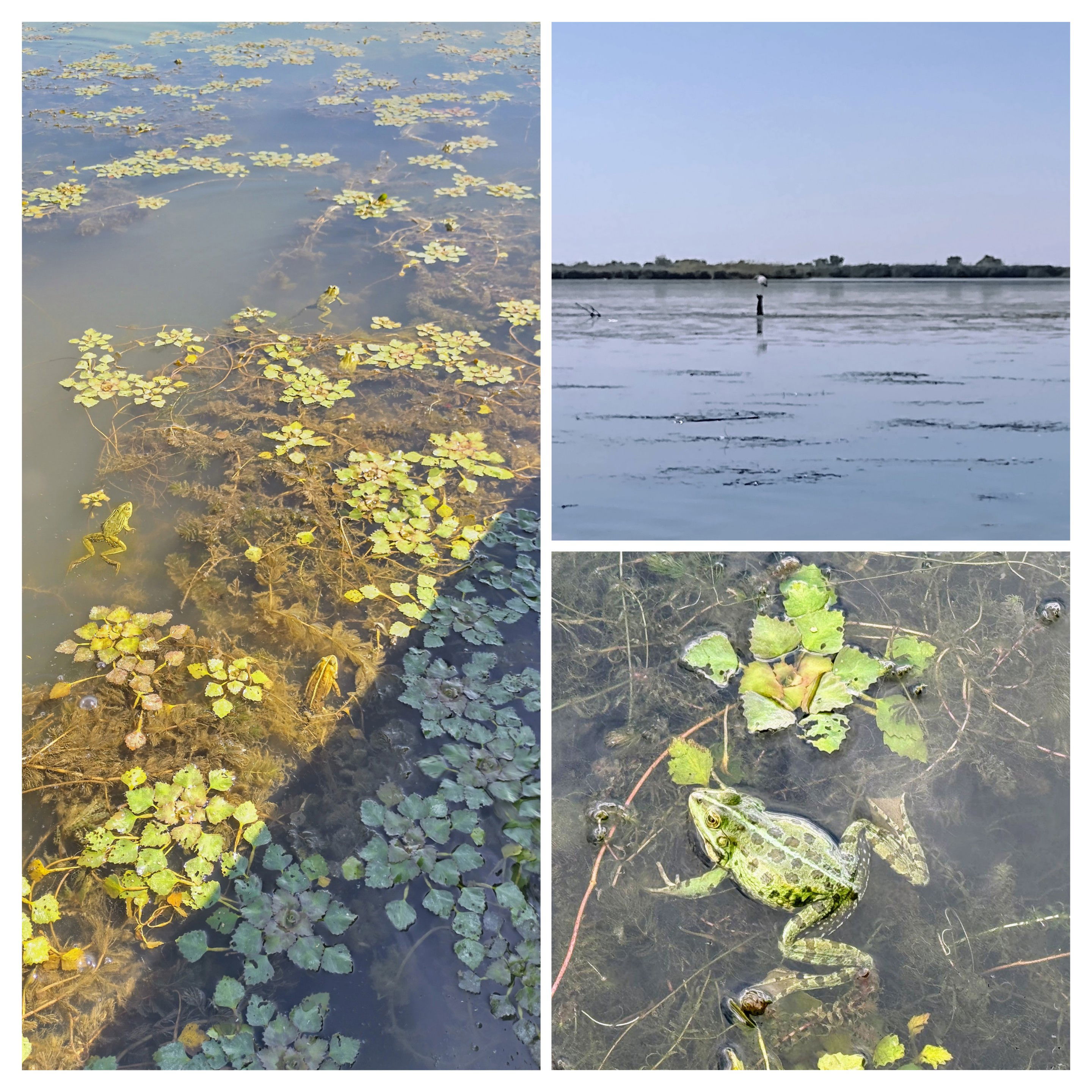
Ciulini de baltă (Trapa natans) și broasca mică de lac (Pelophylax esculentus); pasăre pe un ciot // The Water caltrop (Trapa natans) and the Common water frog (Pelophylax esculentus); bird on a stump
Matineul broaștelor pe lacul Rădăcinos // The frog matinee on the Rădăcinos lake
Un stârc cenușiu (Ardea cinerea) la masă // A grey heron (Ardea cinerea) at lunch
De la lacul Rădăcinos am continuat spre lacul Trei Iezere, pe canalul cu același nume.
From Rădăcinos Lake, we continued to Trei Iezere lake via the canal with the same name.
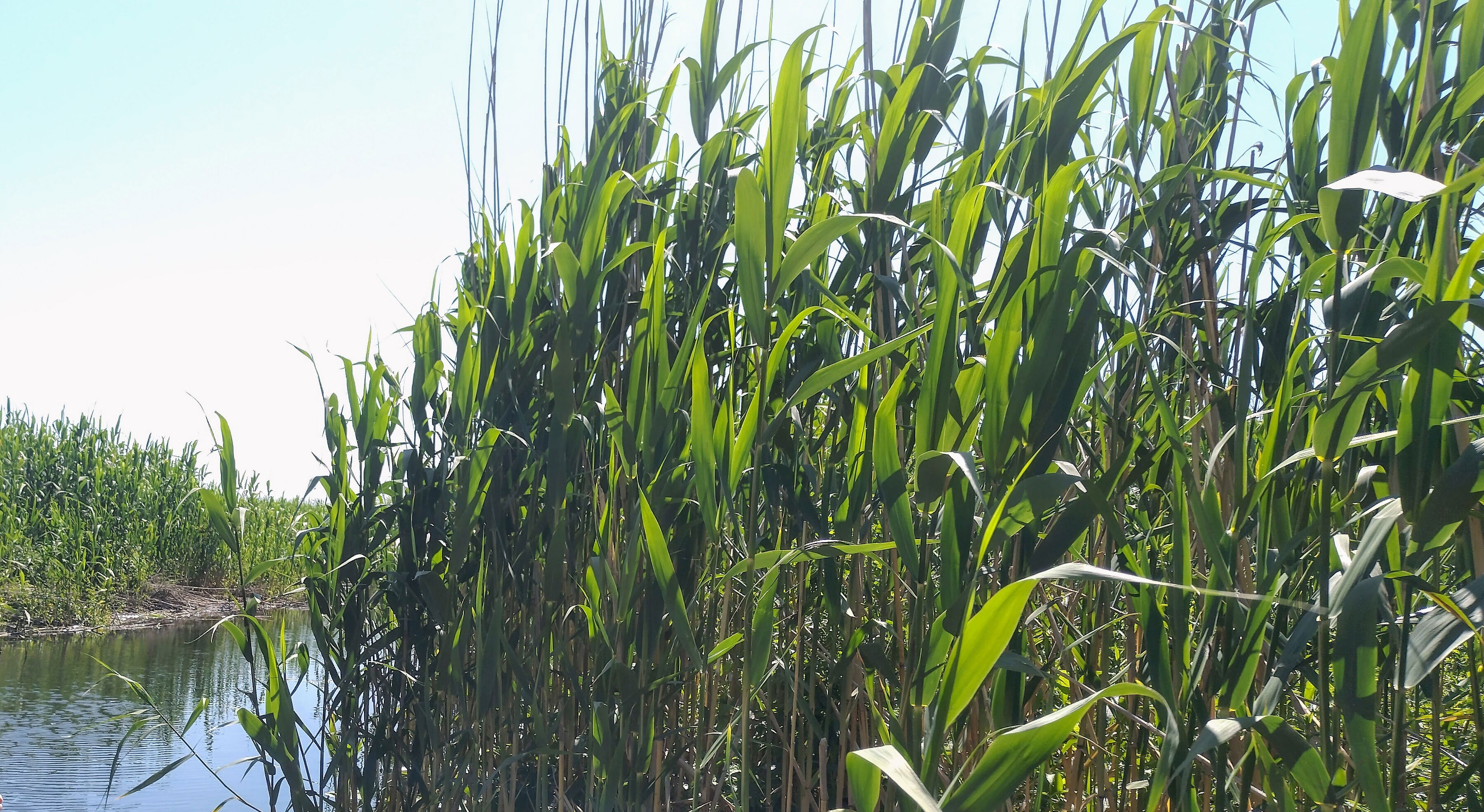
Dreapta, spre lacul Trei Iezere // To the right, towards Trei Iezere lake
Pe lacul Trei Iezere am văzut primele pături de nuferi, atât albi cât și galbeni. Mă fascinează aceste plante, atât de perseverente!
On Trei Iezere lake, we saw the first blankets of water lilies, both white and yellow. These plants, so persistent, fascinate me!
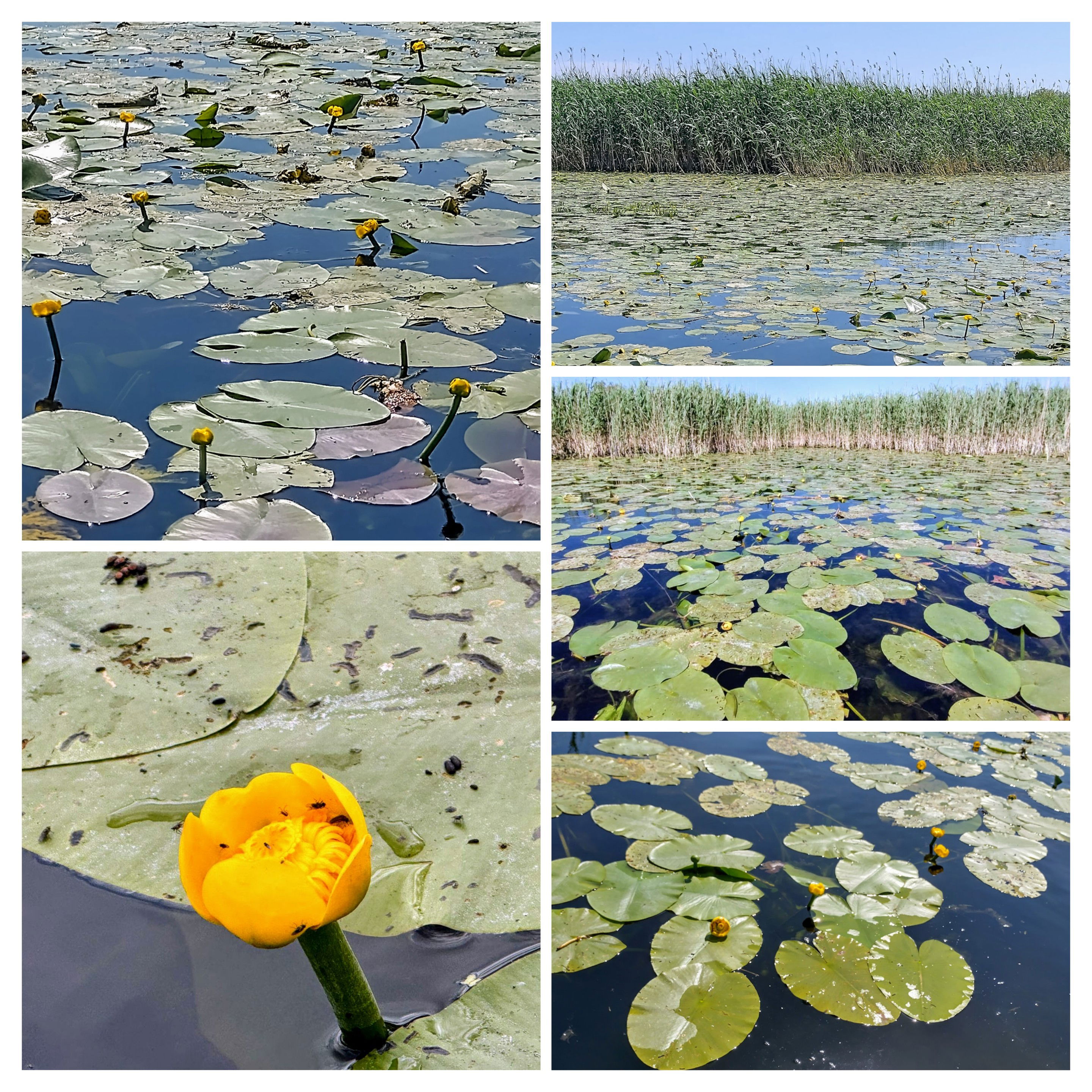
Nufărul galben (Nuphar lutea) // Yellow waterlily (Nuphar lutea)
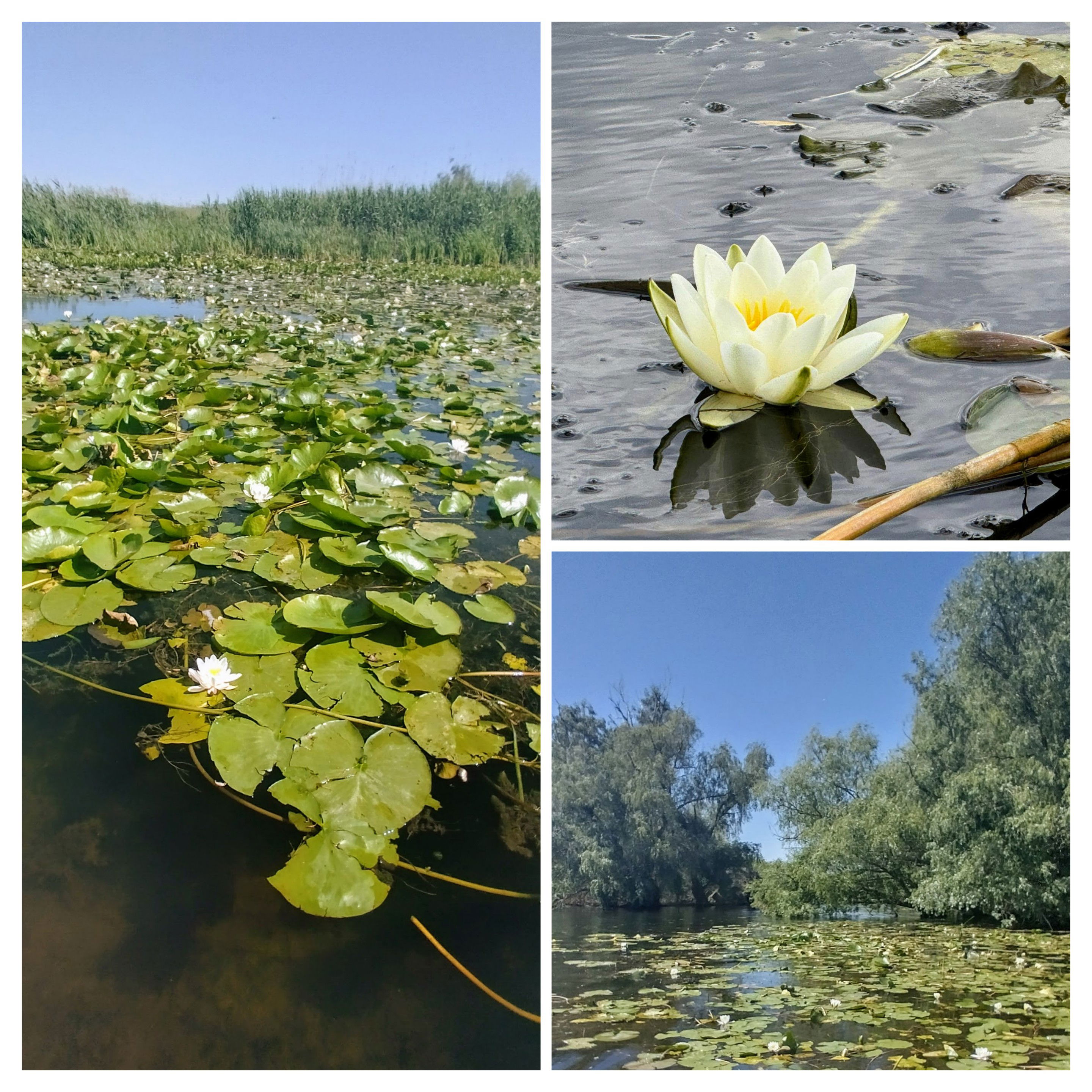
Nufărul alb (Nymphaea alba) // White waterlily (Nymphaea alba)
Lacul se numește Trei Iezere pentru că s-a format din unirea a trei lacuri mai mici, atunci când plaurii care le delimitau s-au mutat.
plaur, plauri, s. m. Formațiune vegetală acvatică, compactă, în care predomină stuful, care plutește la suprafața apei. cf. ucr. plav
Astfel, peisajul e veșnic în schimbare aici, în Deltă. Pe o altă latură a lacului aveam să vedem și un copac răsturnat, dezrădăcinat. Cupola rădăcinii sale a creat un soi de scorbură, sau peșteră, ceva de-a dreptul vrăjitoresc!
The lake is called Trei Iezere because it was formed from the merging of three smaller lakes when the floating reed islands that separated them moved.
Thus, the landscape here in the Delta is always changing. On another side of the lake, we saw an uprooted tree. The dome of its roots created a sort of hollow, or cave, something truly witchy!

Am urmat apoi bucla care pe hartă apare ca și canalul Eracle, dar pe care Iulian ne-a prezentat-o drept canalul natural Lopatna; aici am văzut iarăși cormorani și lebede, și am învățat despre stuful vechi și nou - cel cu ciufurile mai înalte, uscate, este stuful vechi, de anul trecut.
We then followed the loop that appears on the map as the Eracle canal but which Iulian introduced us to as the natural Lopatna canal; here we saw cormorants and swans again and learned about the old and new reeds - the taller, dried ones are the old reeds, from last year.

Stuf (Phragmites australis) cu cormorani și lebădă pe canalul Lopatna // Reeds (Phragmites australis) with cormorants and swan on the Lopatna canal
Au urmat apoi lacurile Caplavataia și Vârșâna, primul netrecut pe hartă, iar al doilea cunoscut și ca Gârla lui Iacob. Aici am trecut printr-un culoar foarte îngust, atingând, practic, stufărișul de pe margini.
Next came the Caplavataia and Vârșâna lakes, the former not marked on the map, and the latter also known as Iacob’s Channel. Here we passed through a very narrow corridor, practically touching the reeds on the sides.
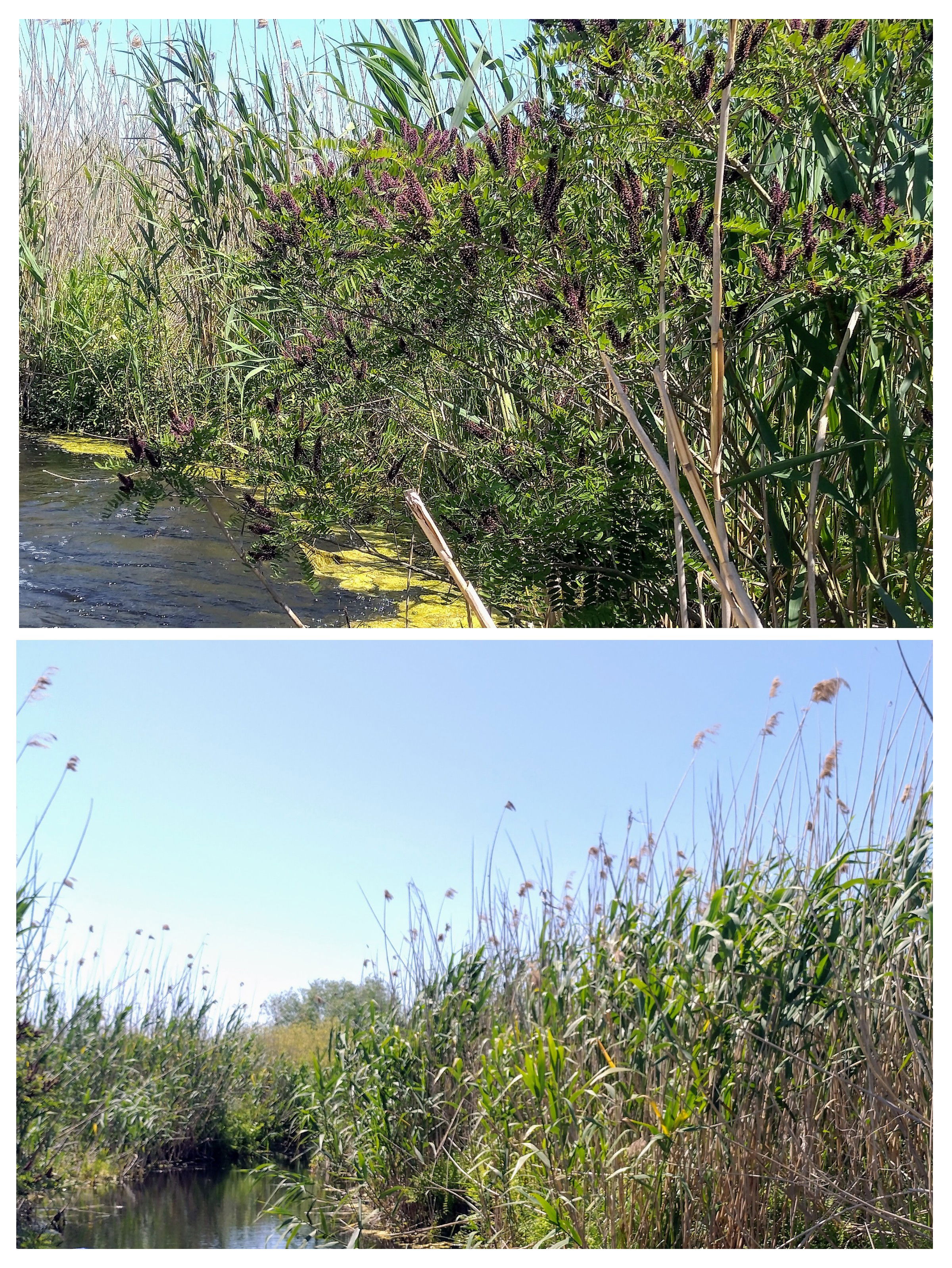
Astfel, am mai adunat cate o omidă pe drum... Pe lacul Vârșâna, Iulian ne-a mai arătat niște plante: menta de apă (Mentha aquatica), pe care am gustat-o și am mirosit-o (e excelentă!), și cactusul de apă (Stratiotes aloides).
Thus, we collected a few caterpillars on the way... On Vârșâna lake, Iulian showed us some more plants: water mint (Mentha aquatica), which we tasted and smelled (it's excellent!) and water soldiers (Stratiotes aloides).
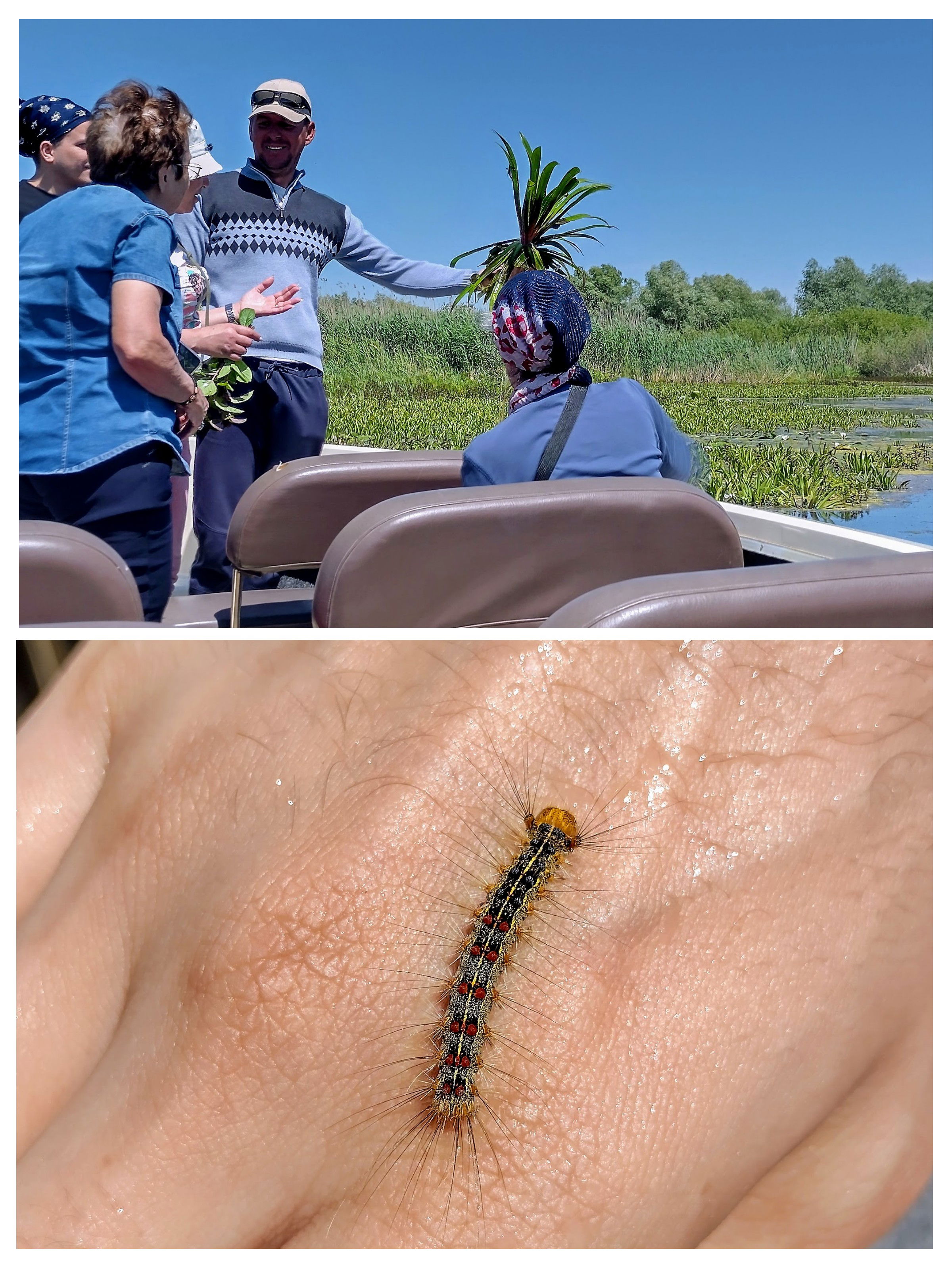
După ce am ieșit de pe lacul Vârșâna, am intrat pe canalul Cațavaia (sau Vișina) - da, înțeleg cum poate deveni foarte greu de urmărit, de aceea am creat hărți! Aici am gustat ceacă (miezul papurei); și acesta, tot excelent! Cu gust și textură de andivă, aceasta se servește de obicei drept garnitură, lângă pește.
After leaving Vârșâna Lake, we entered the Cațavaia (or Vișina) canal - yes, I understand how it can be very hard to follow, which is why I made maps! Here we tasted the core of the cattail; it’s also excellent! With the taste and texture of endive, it is usually served as a side dish with fish.
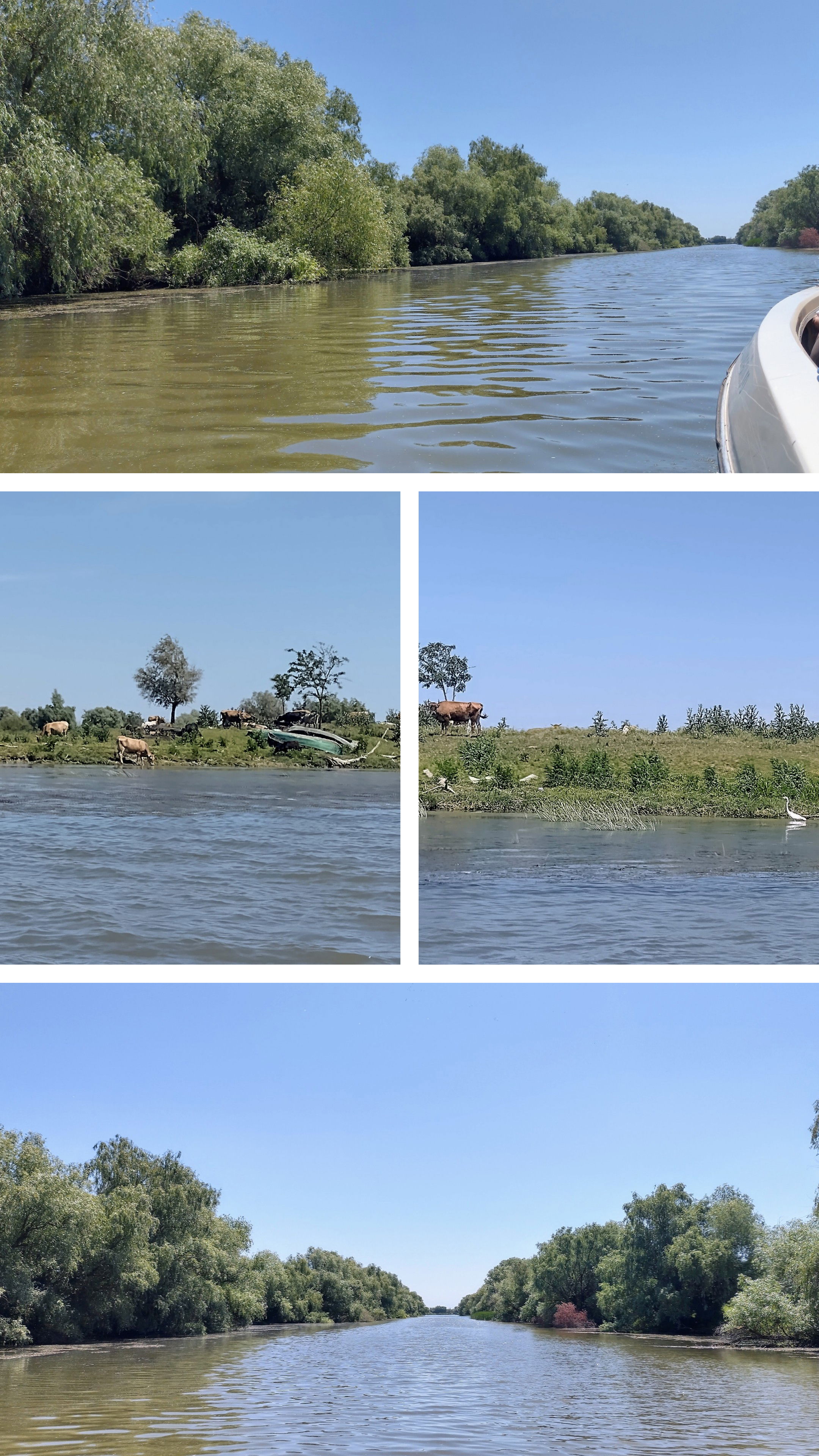
Canalul Cațavaia și vaci păscând aproape de Mila 23 // The Cațavaia canal and grazing cows near Mila 23
Ne-am întors la Mila 23 pentru prânz (unul mai consistent decât mentă și ceacă!) și, după prânz, am ales să facem pe cont propriu (dar tot cu ajutor de la gazde și ghid), o vizită la Biserica Lipovenească de Rit Vechi (Staroveră) "Mihail și Gavril". Dacă pe dinafară v-am arătat-o ieri, vă arătăm azi și interiorul, în toată splendoarea sa albastră. Ce e interesant e că, atunci când această bisericuță a fost renovată, ea nu a mai fost pictată, optându-se în schimb pentru icoane înrămate care s-o tapeteze.
We returned to Mila 23 for lunch (something more substantial than mint and cattail core!) and, after lunch, chose to make a visit on our own (but still with help from the hosts and guide) to the Old Rite Lipovan (Starover) Church "Michael and Gabriel". If we showed you the outside yesterday, today we show you the interior, in all its blue splendor. Interestingly, when this small church was renovated, it was no longer painted, having opted instead for framed icons to decorate it.

Steluțe și icoane în biserica lipovenească // Stars and icons in the Lipovan church
Ghid aici ne-a fost diaconul bisericii, care a moștenit și chemarea și meseria de la ai lui. Slujbele le ține în limba slavonă veche, și ne-a demonstrat și nouă câte ceva, totodată învățându-ne despre cultul starover.
Our guide here was the church's deacon, who inherited both the calling and the profession from his ancestors. The services are held in Old Slavonic, and he demonstrated some to us while also teaching us about the Starover faith.
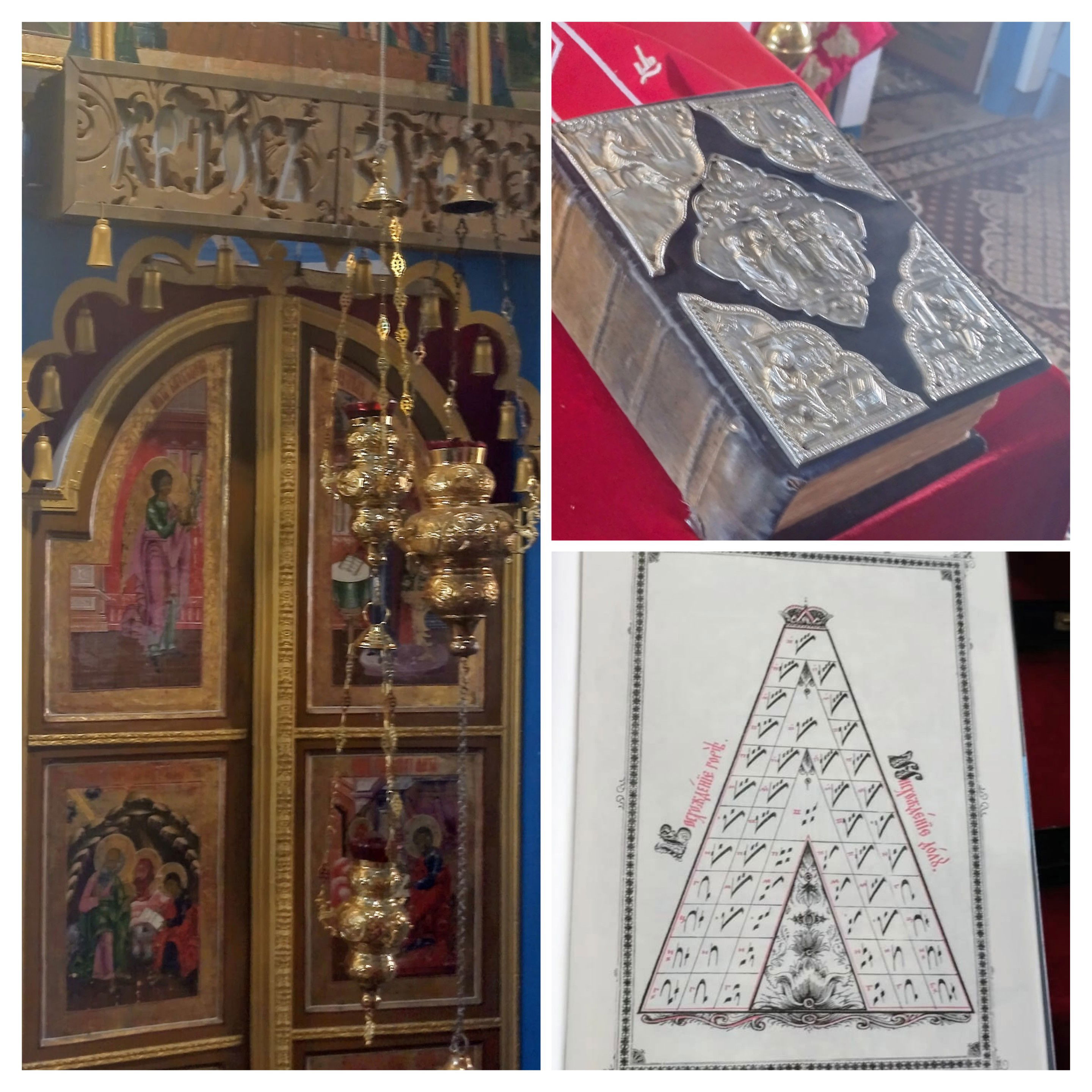
...cu credință și răbdare // ...with faith and patience
După siestă, am pornit pentru a doua tură de lacuri, de data aceasta pe partea stângă. Am ieșit tot pe canalul Cațavaia/Vișina, până la canalul Ligheanca și apoi, pe lacul Ligheanca.
After a siesta, we set out for the second lake tour, this time to the left. We exited again on the Cațavaia/Vișina channel, to the Ligheanca canal, and then to the Ligheanca lake.

Canalul Ligheanca și intrarea pe lacul Ligheanca // The Ligheanca canal and the entrance to the Ligheanca lake
Am parcurs apoi rapid lacul și canalul Văcaru, înspre canalul și lacul Furtuna, unde ne-am oprit pentru a admira peisajul. În zare se văd dealurile Beștepe, dincolo de brațul Sfântu Gheorghe! Lacul Furtuna este și cel mai mare dintre lacurile pe care le-am vizitat în Deltă.
We then quickly passed through the Văcaru lake and canal, towards the Furtuna canal and lake, where we stopped to admire the landscape. In the distance, you can see the Beștepe hills, beyond the Saint George arm! Furtuna Lake is also the largest of the lakes we visited in the Delta.
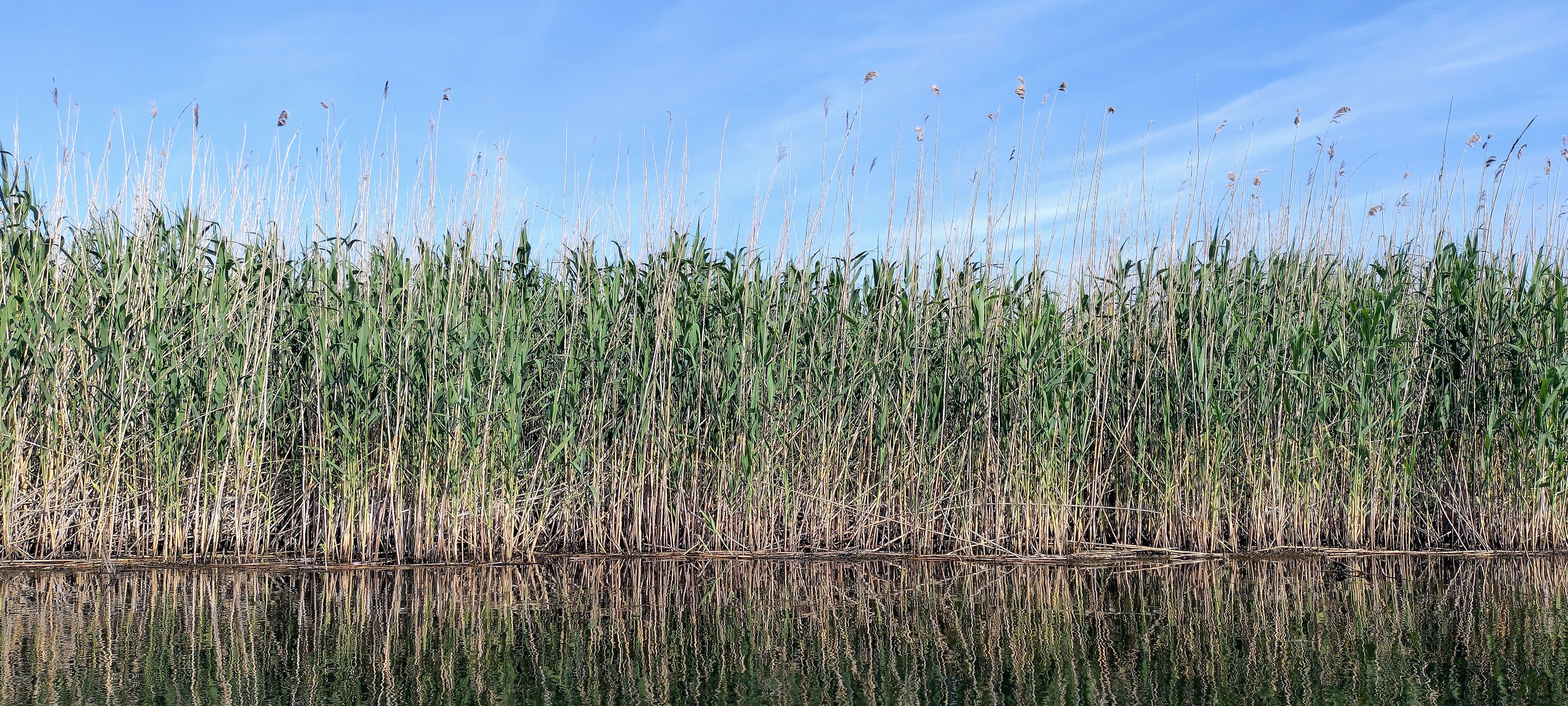
Stufăriș pe canalul Furtuna // Reeds on the Furtuna canal

Peisaj pe lacul Furtuna // Landscape on Furtuna lake
Am coborât din lacul Furtuna spre fosta orezărie din spatele satului Maliuc; aceasta nu a fost rentabilă și proiectul a fost abandonat. Am ocolit-o și am intrat, din nou, pe gârla Șontea, mai exact pe canalul Șontea Lată.
We descended from Furtuna lake towards the former rice fields behind the village of Maliuc; these were not profitable, and the project was abandoned. We bypassed it and entered again on the Șontea channel, specifically on the Șontea Lată canal.

Șontea Lată: Lebede și salcâmi sălbatici (Amorfa fruticosa) // Șontea Lată: Swans and False indigo (Amorfa fruticosa)
Aici am văzut puzderie de păsări, de la cele cu care deja ne-am obișnuit, la chire de baltă și rarii codalbi.
Here we saw a multitude of birds, from those we were already familiar with to the marsh terns and rare white-tailed eagles.
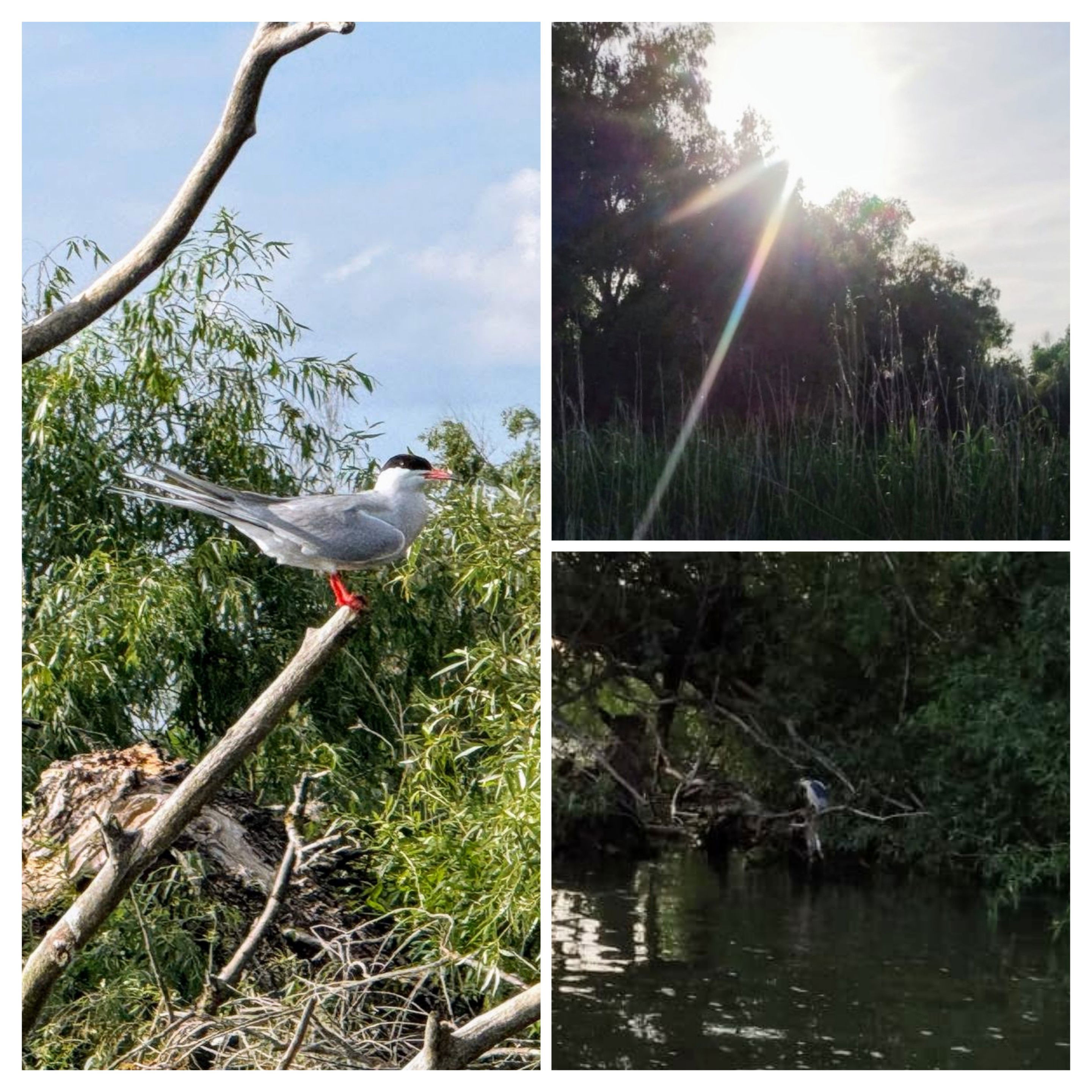
Chira de baltă (Sterna hirundo); curcubeul într-o rază de soare // The Common tern (Sterna hirundo); the rainbow in a sunbeam
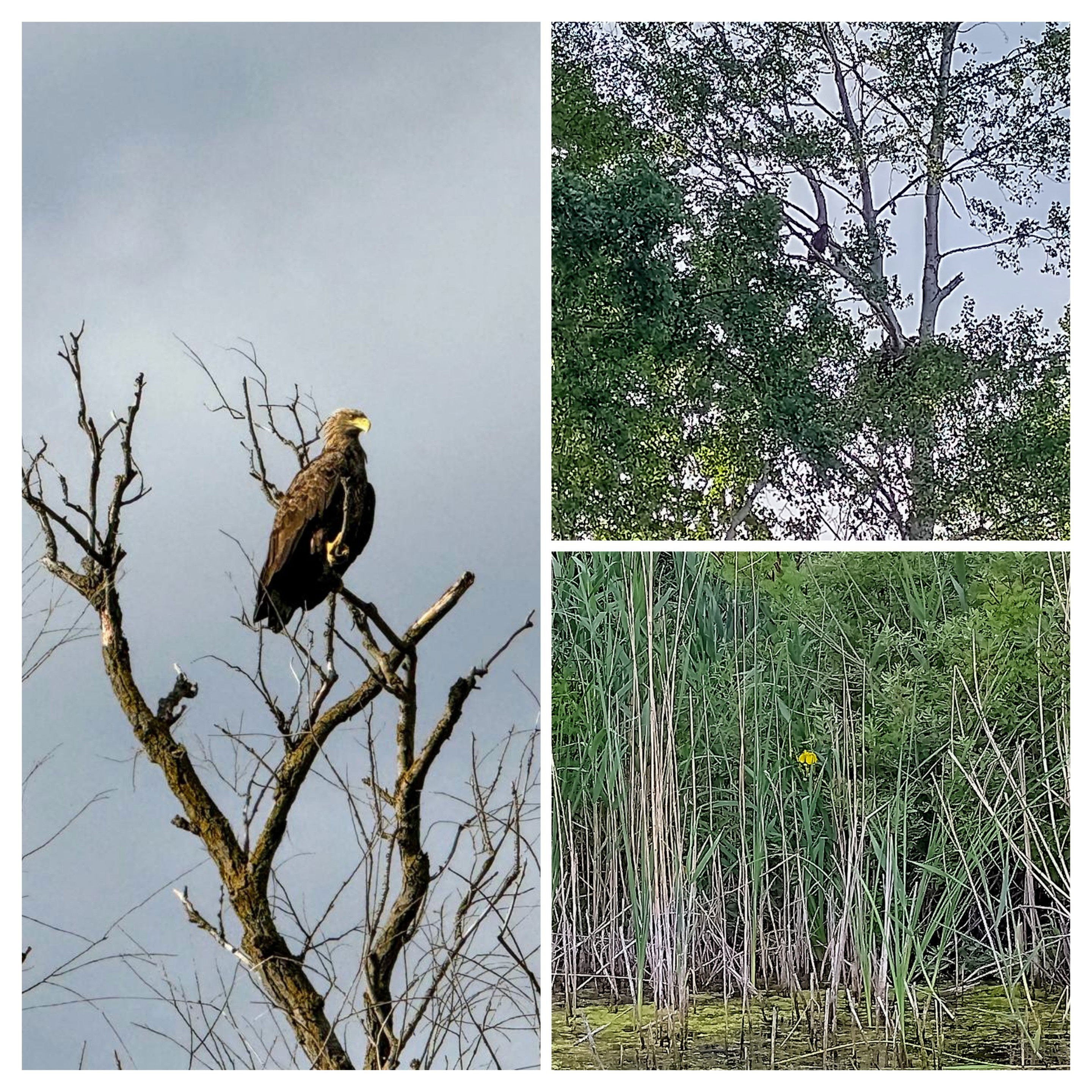
Vulturul codalb (Haliaeetus albicilla); un frumos stânjenel de baltă (Iris pseudacorus) // The White-tailed eagle (Haliaeetus albicilla); a pretty Yellow iris (Iris pseudacorus)
Am mai văzut de aproape și spectacolul rusaliilor (Palingenia longicauda), cunoscute și ca efemeride. Acestea eclozează doi ani sub apă, pentru a ieși la suprafață doar pentru câteva ore, în care se împerechează, depun ouăle și apoi mor - un efort imens pentru o moștenire genetică... Seara trecută le văzuserăm cu zecile de mii, survolând Dunărea, și n-am știut ce sunt. Trupurile lor cu miile de a doua zi dimineața ne-au făcut să întrebăm și să le aflăm povestea.
We also saw up close the spectacle of the mayflies (Palingenia longicauda), also known as ephemerides. These insects emerge after two years underwater, to surface only for a few hours, during which they mate, lay eggs, and then die - an immense effort for a genetic legacy... The night before, we had seen them by the tens of thousands, flying over the Danube, and didn’t know what they were. Their thousands of bodies the next morning prompted us to ask and learn their story.
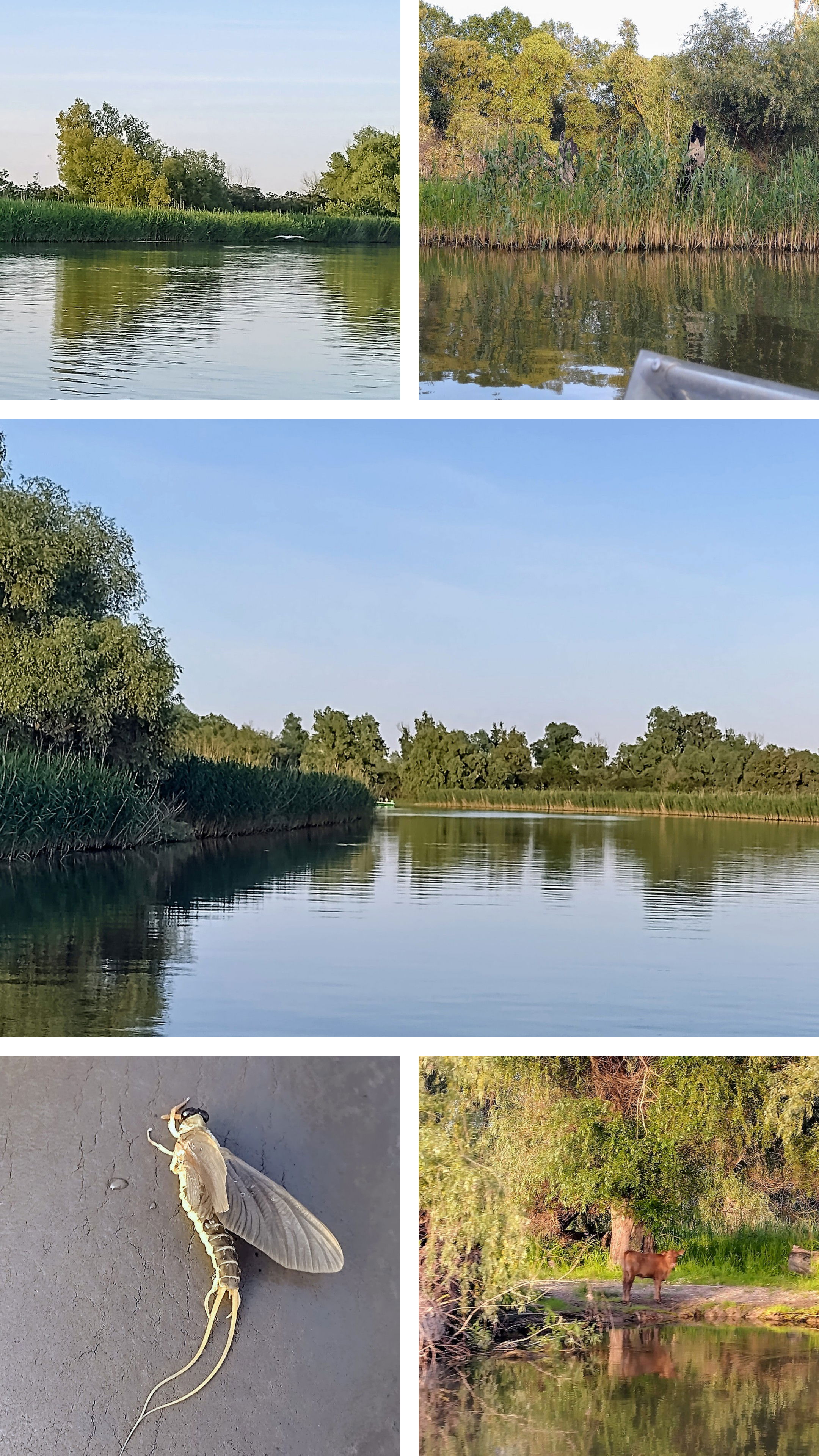
Animale și plante pe gârla Șontea; st. jos, efemeridă // Animals and plants on the Șontea channel; bottom left, ephemeride
Rusalii (Palingenia longicauda), via SOR // Mayflies (Palingenia longicauda), via SOR
Am intrat înapoi pe Dunărea Veche, unde ne-au întâmpinat prietenii noștri, pelicanii.
We entered back on the Old Danube, where our friends, the pelicans, greeted us.
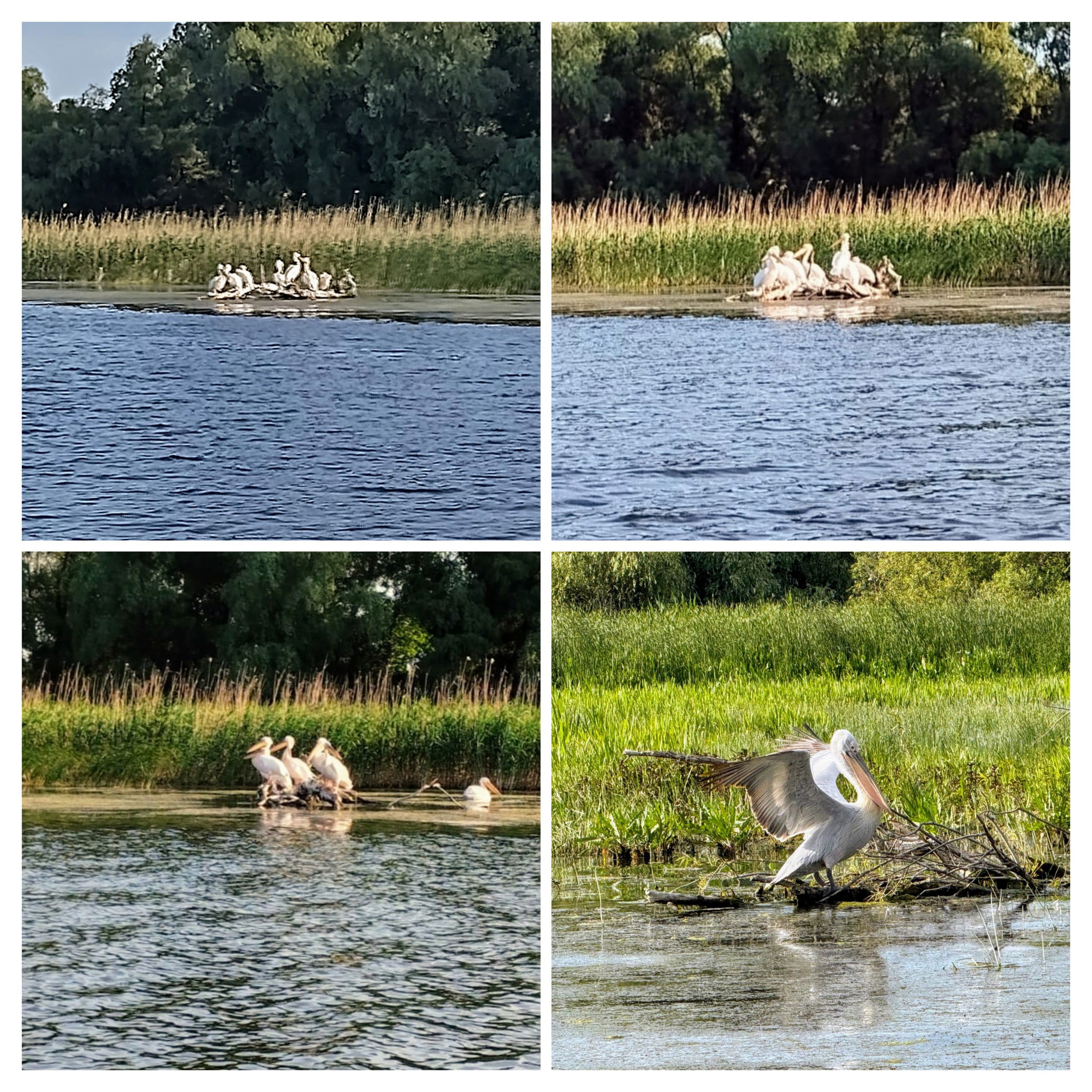

Ne-am întors apoi la cazare pentru a continua, după cină, înapoi pe lacul Ligheanca pentru a vedea apusul.
We then returned to our accommodation to continue, after dinner, back on Ligheanca lake to watch the sunset.
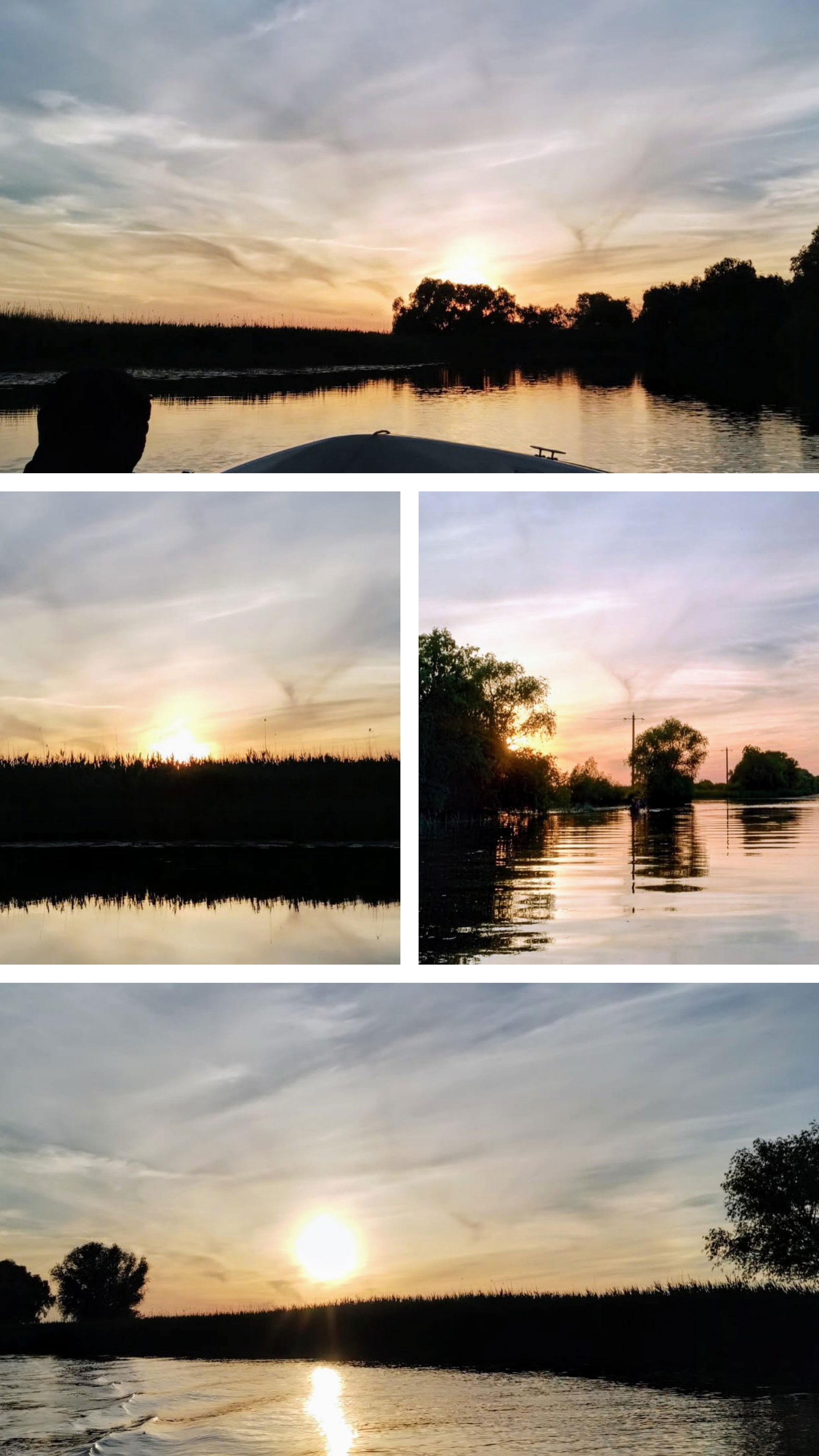
Spectacolele pe care le dă apusul în Deltă nu sunt deosebite doar prin culorile de pe cer, care sunt cu totul altfel decât le vedem filtrate prin smogul urban, dar și prin felul cum acestea se oglindesc în luciul apei.
The sunsets in the Delta are remarkable not only for the colors in the sky, which are entirely different from those seen filtered through urban smog but also for how they reflect on the water's surface.
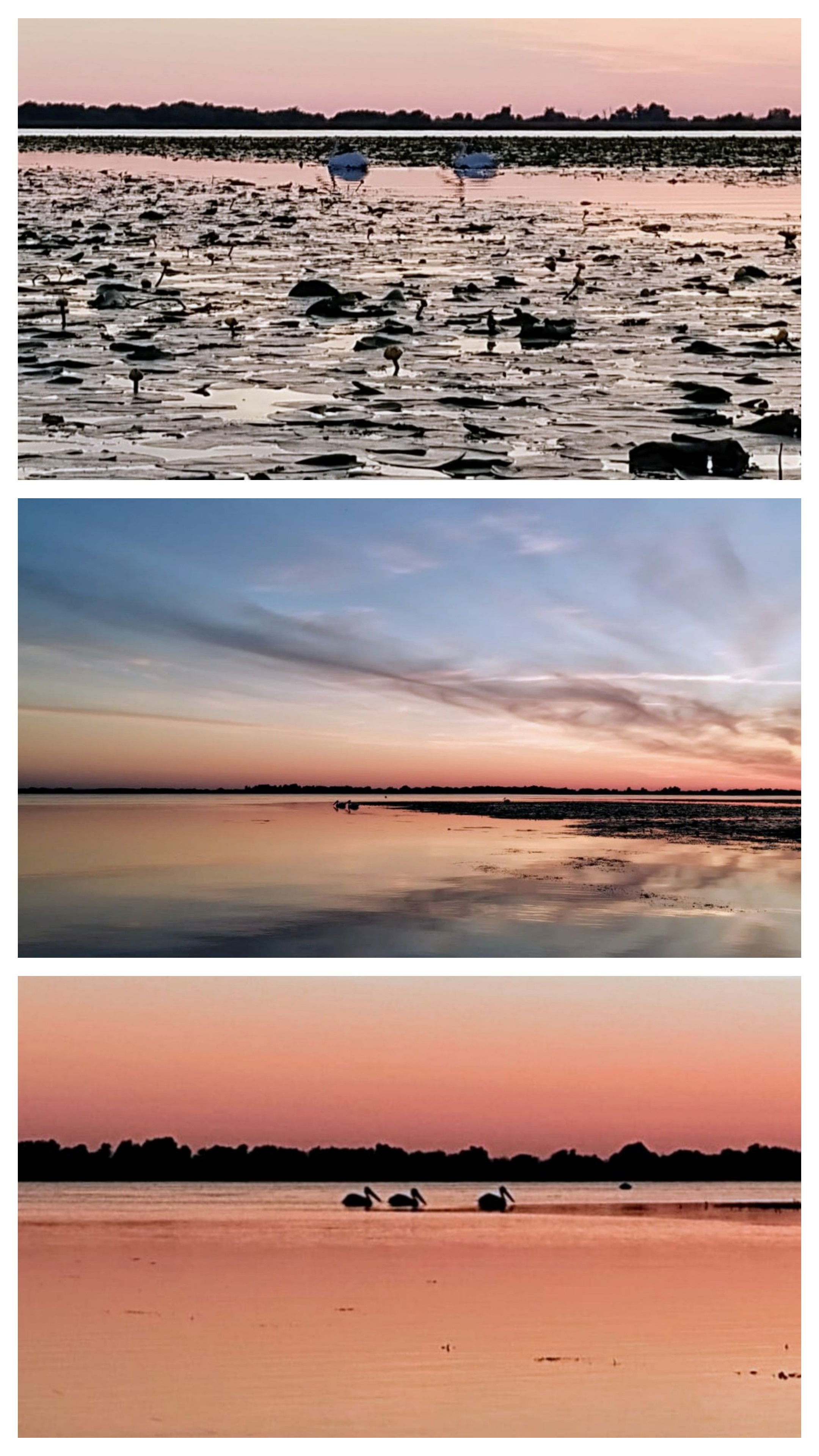
Apus cu pelicani // Sunset with pelicans
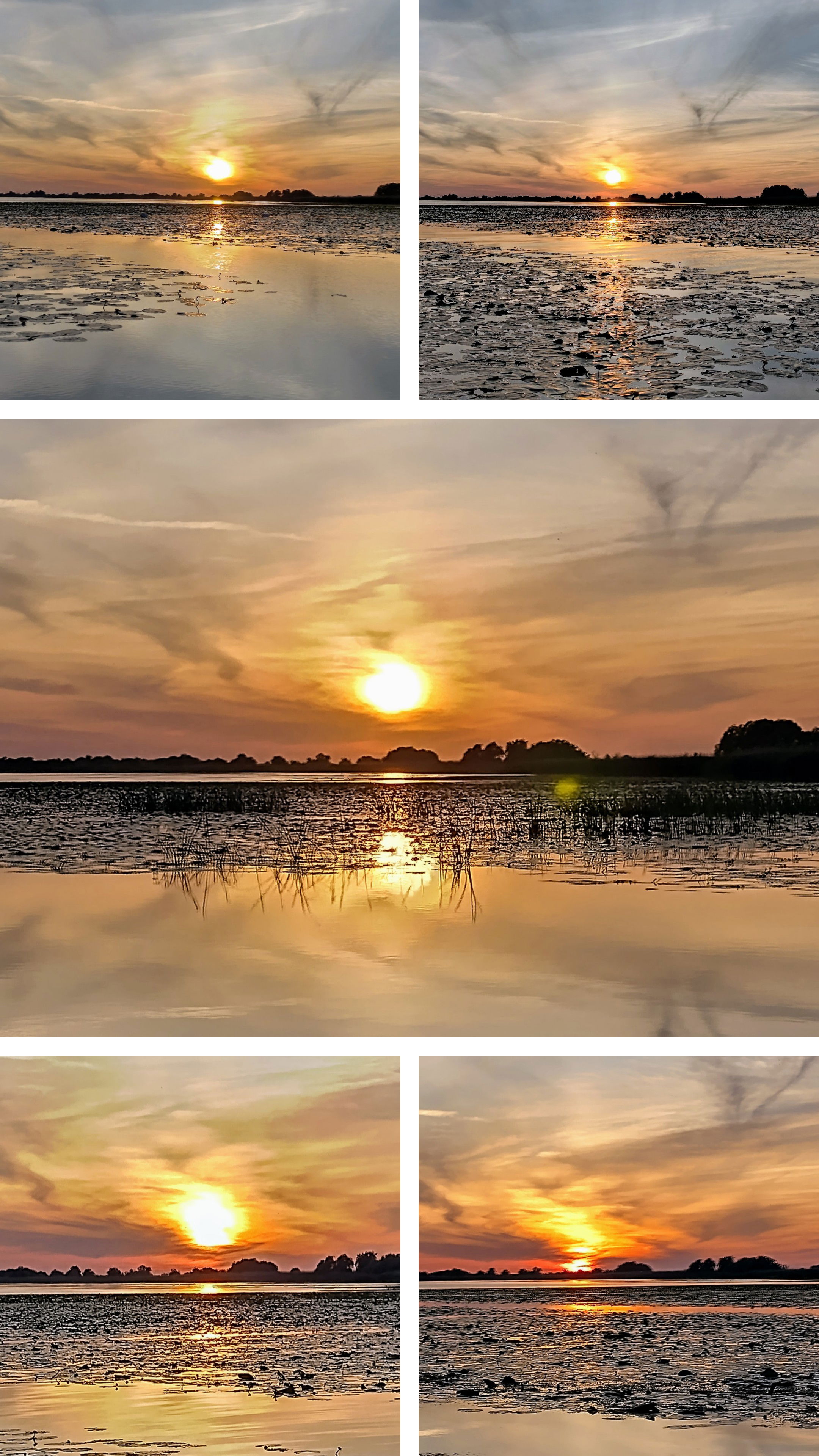

Apus cu nuferi // Sunset with water lilies
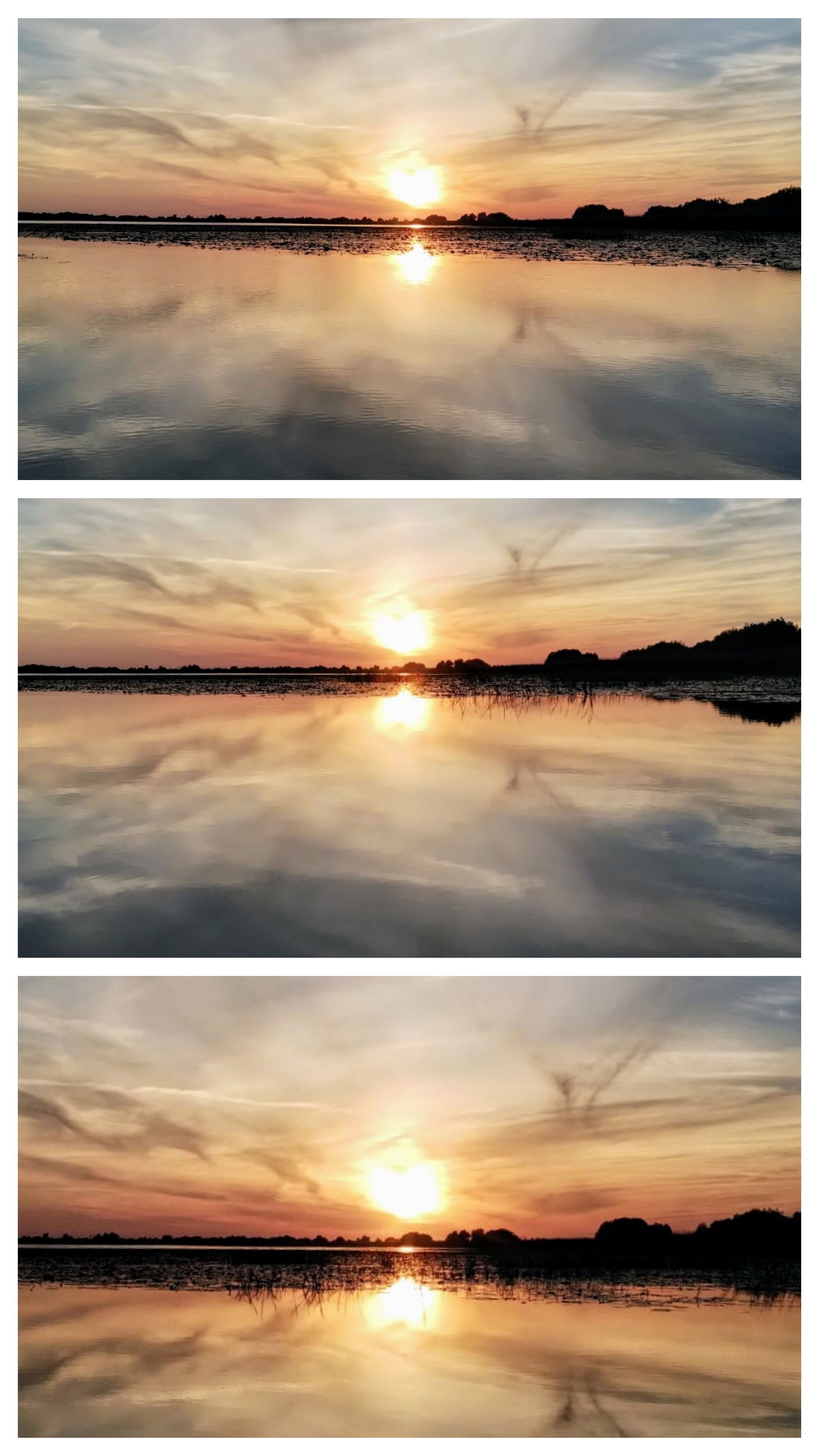
Apus oglindit // Mirrored sunset
Apus cu de toate // Sunset with all the fixings
Ne-am întors la bază, de unde, ziua următoare, aveam să plecăm spre Letea. Letei (și ultimei nopți în Mila) îi dedic alt articol, chiar dacă face parte din aceeași excursie, pentru că, administrativ, ține de altă comună (Mila 23 e în Crișan, iar Letea e în C.A. Rosetti), și pentru că acest articol deja e lung destul.
La Mila 23 ne mai întoarcem, pentru Muzeul Ivan Patzaichin, și pentru încă o tură de lacuri, căci au rămas destule nevăzute!
We returned to the base, from where, the next day, we were to head to Letea. To Letea (and our last night in Mila) I’ll dedicate another article, even though it’s part of the same trip, because administratively, it belongs to another commune (Mila 23 is in Crișan, and Letea is in C.A. Rosetti), and because this article is already long enough.
We will return to Mila 23 for the Ivan Patzaichin Museum and for another lake tour, as there are plenty left unseen!
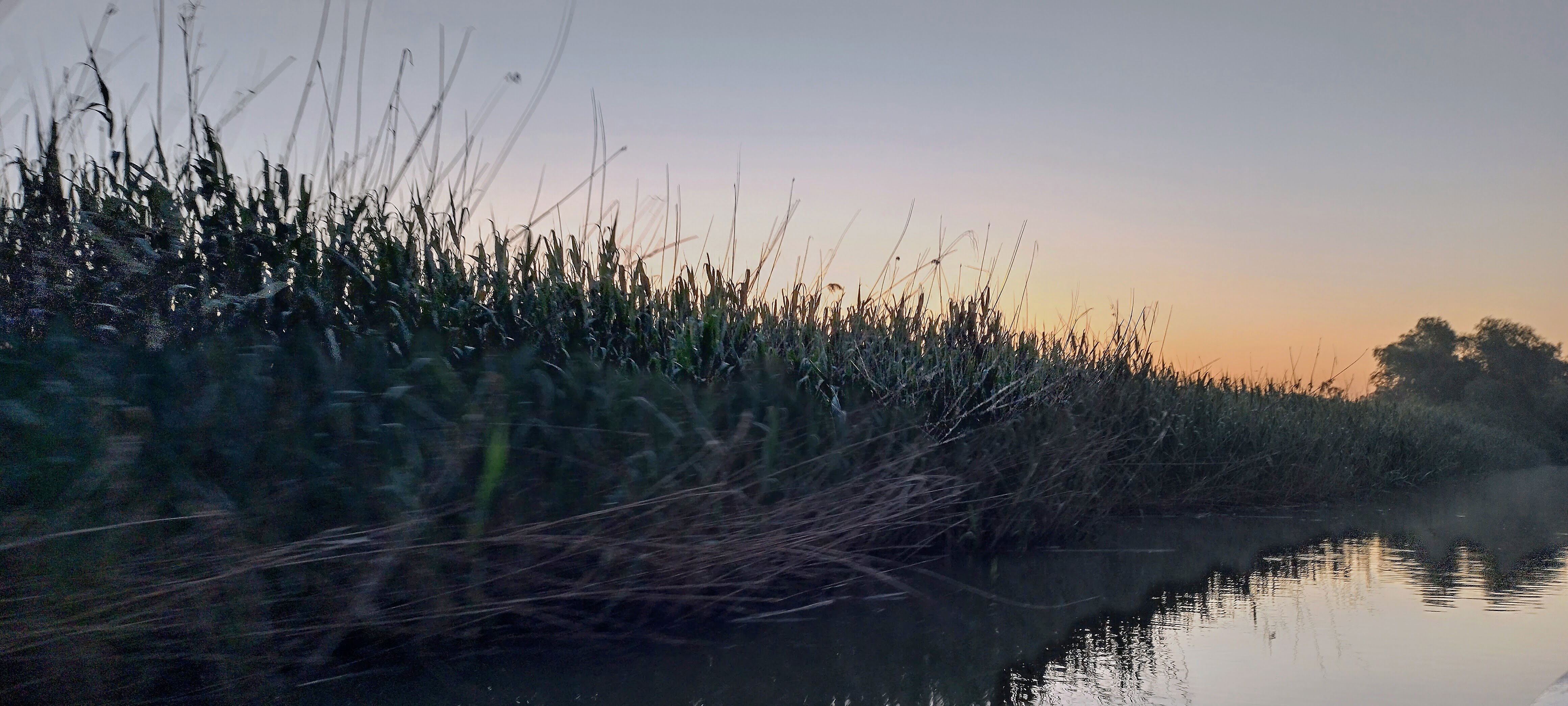
- Cost/Durată: toate detaliile pe descoperadeltadunarii.ro
- Verdict: 10/10 - merită absolut!
- Cost/Duration: All details on descoperadeltadunarii.ro
- Verdict: 10/10 - absolutely worth it!
